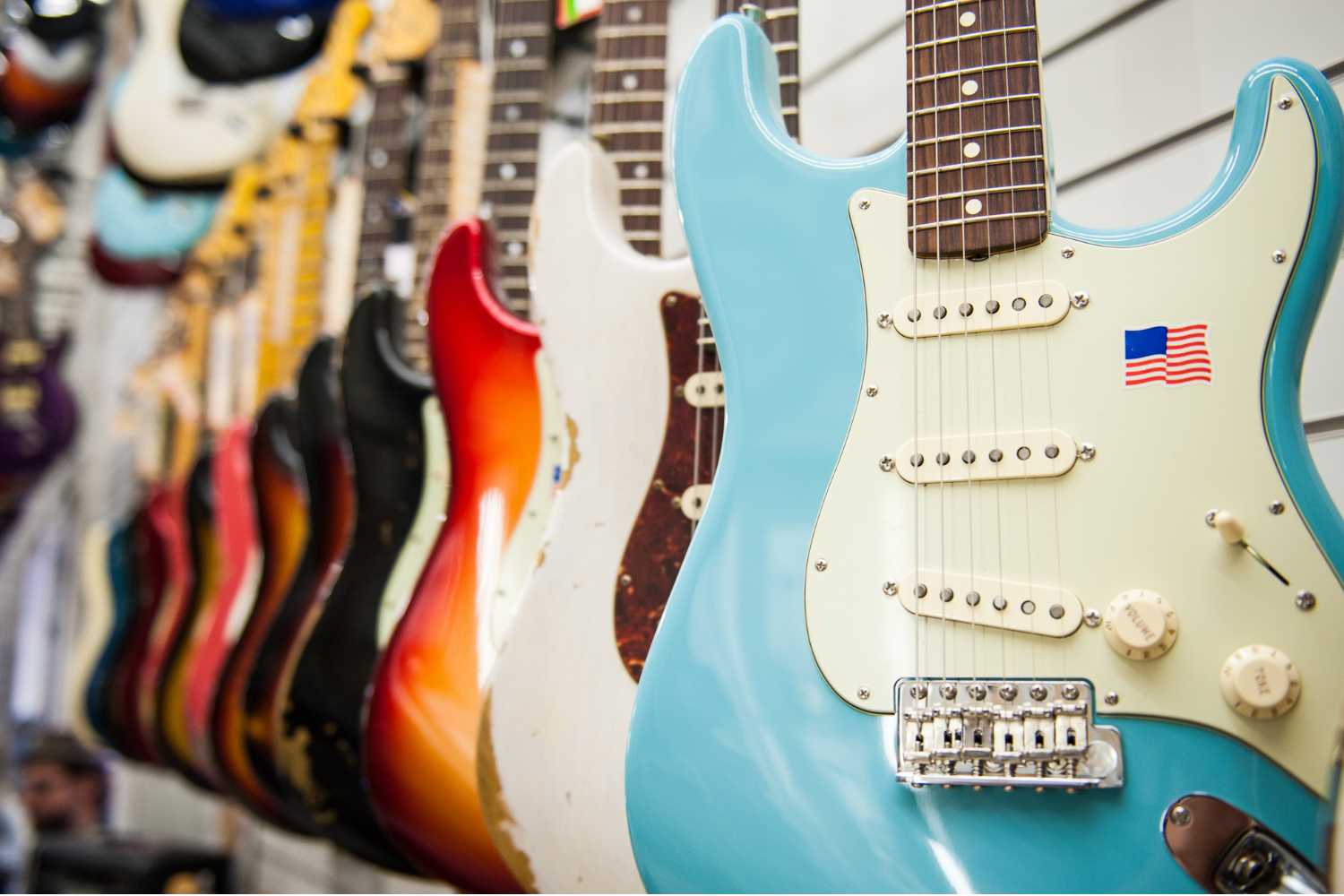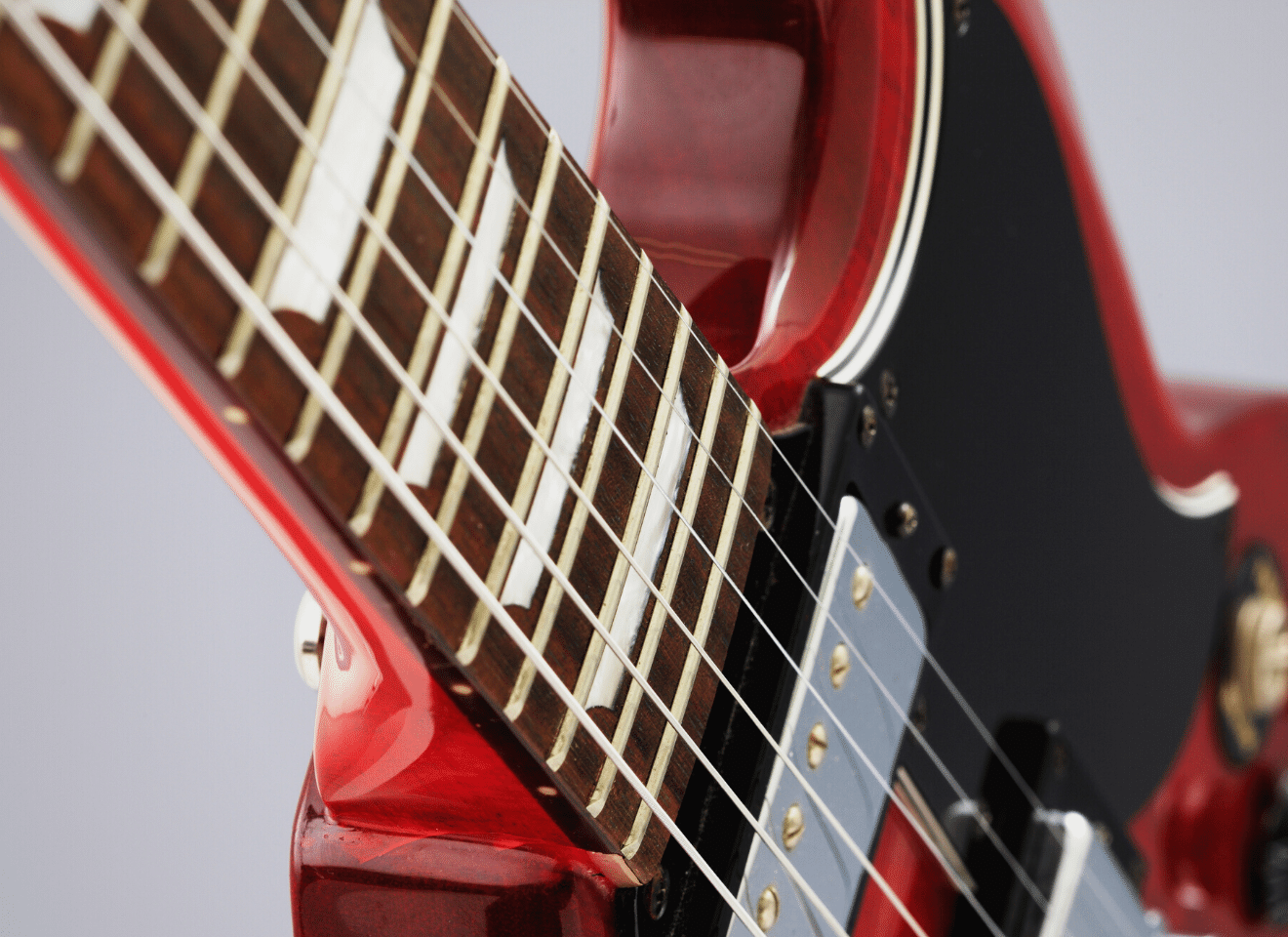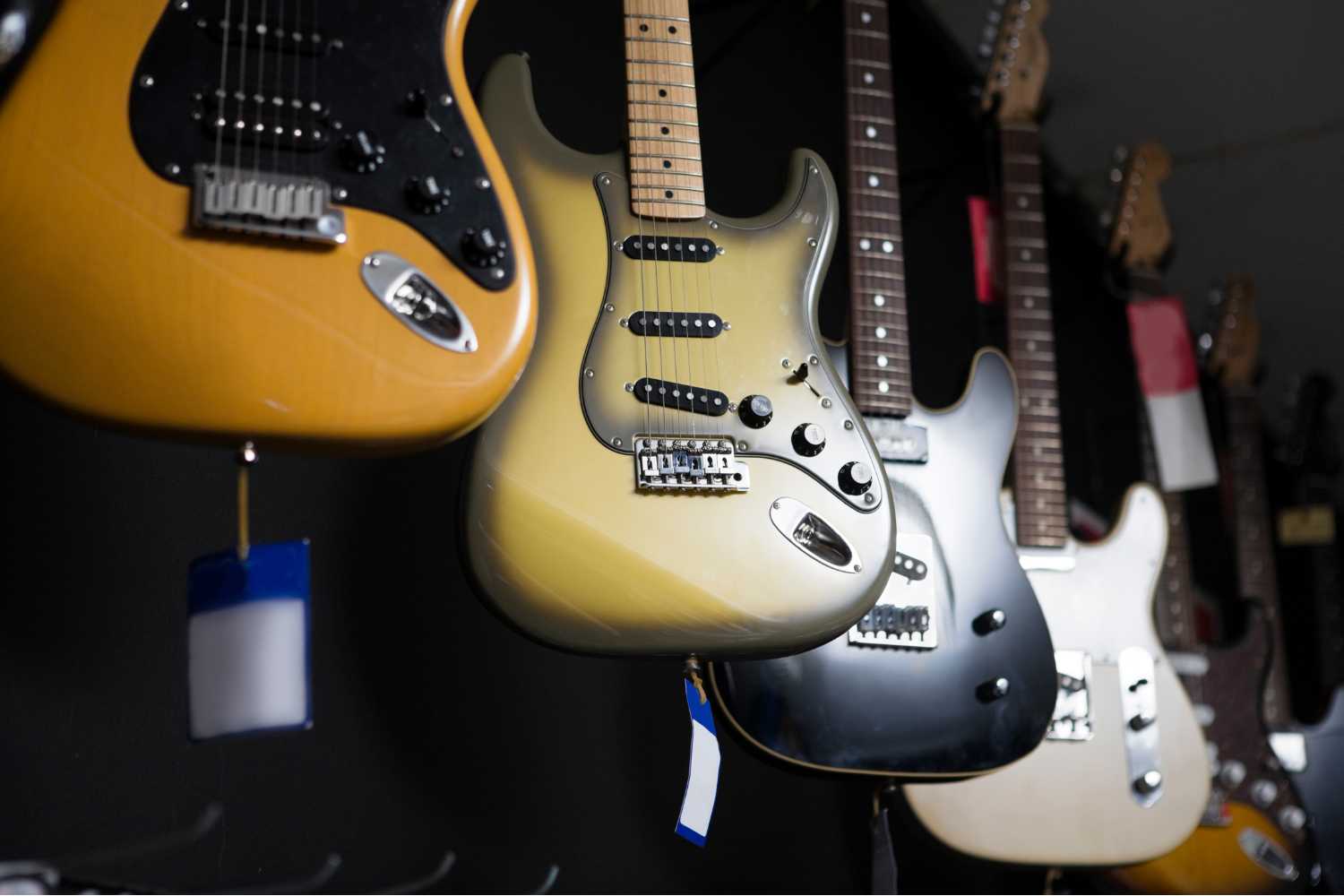Every guitarist holds a unique perception regarding what encompasses the ‘perfect’ gigging electric guitar.
Various factors such as playability, tonal range, durability, and aesthetic appeal contribute to that decision.
Undeniably, the market is flooded with numerous electric guitars that meet different individual needs and preferences.
Whether you are a seasoned professional seeking to add a reliable workhorse to your collection or an upcoming artist searching for your first gig-worthy companion, making the right choice may seem daunting.
However, armed with the right knowledge, this process can be significantly simplified and made enjoyable.
This article boasts a carefully curated selection of electric guitars perfect for live performances and is sure to provide valuable insight in your quest for the perfect instrument.
Table of Contents
- Best Electric Guitars For Gigging
- Ibanez RG550 Genesis Electric Guitar
- Fender American Professional II Stratocaster Electric Guitar
- Squier Classic Vibe 50s Stratocaster Electric Guitar
- PRS SE Custom 24 Electric Guitar
- Fender Vintera 70s Deluxe Telecaster Electric Guitar
- ESP LTD EC-1000 Electric Guitar
- Yamaha Revstar Standard RSS20 Electric Guitar
- Gibson Les Paul Standard ’50s P90 Electric Guitar
- PRS Guitars SE McCarty 594 Electric Guitar
- Fender Player Jaguar Electric Guitar
- Squier J Mascis Jazzmaster Electric Guitar
- Ibanez S670QM S Series Electric Guitar
- Gibson Custom ES-335 Electric Guitar
- Ibanez Artcore Series AS73G Semi-Hollowbody Electric Guitar
- Epiphone Sheraton II Pro Electric Guitar
- What to Look for When Purchasing Electric Guitars for Gigging?
- How Do You Determine Guitar Quality?
- Is Wood Quality Important for Electric Guitars?
- How Essential is the Pick-Up System for Electric Guitars?
- What Role Does the Neck Play in Electric Guitars?
- Can You Explain the Importance of Guitar Electronics?
- How to Maintain Electric Guitars for Gigging?
- Are Some Electric Guitars More Durable for Gigging?
- Does the Guitar Size Impact its Sound Output?
- What Kind of Electric Guitar Strings are Best for Gigging?
- The Bottom Line
Best Electric Guitars For Gigging
Before I begin, here are my top selected choices:
|
|
PRS SE Custom 24 Electric Guitar

Iconic guitar with solid mahogany body and tremolo. Check Price
|
Squier Classic Vibe 50s Stratocaster Electric Guitar

Fender-designed with vintage-inspired accents.
Check Price
|
Ibanez RG550 Genesis Electric Guitar
Superb Japanese craftsmanship with versatile tone versatility.
Part of the Ibanez RG Genesis Collection, this 6-string electric guitar features craftsmanship and design reminiscent of the original RG line. It showcases a Super Wizard Maple/Walnut neck for smooth playing, and a combination of V7, S1, and V8 pickups that allows for a versatile range of tones. Its Edge Tremolo Bridge provides precise intonation adjustment and superior playing comfort.

This electric guitar from Ibanez RG Genesis Collection truly embodies the original essence of the RG lineup. Known for its precision-built Japanese craftsmanship, it prides itself on having an intricate design and aesthetic value.
The guitar features a Super Wizard 5-piece Maple/Walnut neck which ensures a smooth and intuitive playing experience.
It also has a unique pickup arrangement including V7 at the neck, S1 in the middle, and V8 at the bridge. This versatile combination allows a wide variety of tonal capabilities, ranging from pristine and clean to gritty and intense.
There’s a maple fretboard too, contributing to the crisp high tones and robust upper mid-ranges.
A distinctive aspect is the guitar’s top-notch Edge tremolo bridge, particularly appreciated for its fantastic tuning stability, precise intonation adjustments, and overall playing comfort.
Breaking down further details, the Ibanez electric guitar has a Purple Neon color, back and body made from Basswood, and a Maple neck.
The fretboard is also of maple wood and it has a unique S pickup configuration. It’s designed for right-hand orientation and features a pioneering Tremolo for its guitar bridge system.
It’s a fresh take on a beloved classic, designed with the hard rock enthusiast in mind.
- My Review
Upon first glance, the Ibanez RG550 RG Genesis Collection Purple Neon guitar is an absolute eye-catcher with its vibrant hue.
Its body crafted with basswood paired with a maple fretboard gives it a sleek and futuristic appeal.
This combined with its Super Wizard 5pc Maple/Walnut neck, not only enhances its aesthetic appeal, but also offers an unprecedented level of comfort while playing.
To my delight, the masterpiece Edge tremolo bridge offers remarkable tuning stability, which is a coveted feature in any good quality electric guitar.
I felt completely at ease, particularly due to the right-hand orientation of the guitar bridge system.
The Maple wood fretboard was another impressive feature, producing crisp, bright highs and strong upper mids which contributed to its superior sound quality.
I must admit, the combination of the V7 neck pickup, S1 middle pickup, and V8 bridge pickup is a masterclass, allowing a variety of tones, from crystal clear to searing and nasty.
Upon testing this guitar, it became evident that it has been constructed with Japanese precision and craftsmanship, and I was able to witness the origins of the RG line first-hand.
Producing variety of tones, the V7 / S1 / V8 pickups were capable of capturing a broad spectrum of sound, catering to different musical genres with equal proficiency.
However, bearing in mind its price, I felt that it could have offered a little more in terms of additional features or accessories.
Contrarily, this guitar is undoubtedly a work of expert artisanship, the ethos of its Japanese roots echoed in the details.
Despite my initial reservations about its cost, the intricate detailing and unbeatable sound quality I experienced painted a clear picture as to why it is priced so.
It is evident that the makers did not compromise on the guitar’s build quality and sound.
From the calming strum of a chord to the exhilarating shred of a solo, every note played on the Ibanez RG550 RG Genesis Collection Purple Neon guitar resonates with intensity and clarity.
This product symbolizes a striking balance of aesthetics, sound quality, performance, and craftsmanship.
- Pros:
- Great sound clarity.
- Comfortable neck design.
- Excellent tuning stability.
- Cons:
- Some customers find it overpriced.
- Quality may feel average to some.
My final verdict is that… the Ibanez RG550 RG Genesis Collection Purple Neon is an exceptional guitar for any hard rock enthusiast.
With its precise Japanese craftsmanship and signature features like the Super Wizard 5pc Maple/Walnut neck, it truly reflects the origins of the RG line.
Its V7 / S1 / V8 Pickup combination allows for a versatile range of tones, making it fit for various music styles.
Lastly, its Masterpiece Edge bridge ensures superior tuning stability for an immaculate performance every time.
Undoubtedly, a worthy reissue of a hard rock classic.
Fender American Professional II Stratocaster Electric Guitar
Elite Stratocaster with exotic wood craftsmanship.
This guitar sports a dark night finish, rugged alder body, and a maple neck complemented by a rosewood fingerboard. It stands out with 3 single-coil pickups and a tremolo guitar bridge system for an ideal musical experience. Encased in the finest materials like maple wood, rosewood, and alder wood, this right-hand-oriented instrument is a sophisticated upgrade of the American Professional Stratocaster series.

If you’re looking for an electric guitar that’s well crafted and has a unique tone, then the Fender American Professional II Stratocaster is worth considering.
Finished in a distinctive deep shade called Dark Night it adds a sleek aesthetic touch to your overall look while performing.
It is a solidbody electric guitar, meaning it’s built with a Alder body, enhancing its durability and sound quality.
It’s equipped with three single-coil pickups which contribute to its rich and full sound.
This particular Stratocaster model – a member of Fender’s beloved American Professional series – features a rosewood fingerboard and a maple neck that provides a comfortable and familiar playing experience.
This guitar’s brand is Fender, a well-known and respected name in the music world.
The top of this guitar is made of maple wood, rosewood, and alder wood, while the back also features rosewood and alder wood.
The materials used in the neck and fingerboard are, respectively, maple and rosewood.
This is a right-handed guitar and it also has a S type guitar pickup configuration, along with a tremolo system in the guitar’s bridge setup.
So, if you are seriously about your performance, this updated take on the American Professional Stratocaster would be a remarkable addition to your gear collection.
- My Review
Upon laying my hands on the Fender American Professional II Stratocaster, I was struck by its lavish dark night color, contrasting beautifully with the rosewood fingerboard.
The solid alder body combined with three single-coil pickups knocked me out with its superlative sound quality.
Nothing short of astounding, the guitar’s maple neck offered a perfect grip and ease while playing, which helped in delivering a clear, vibrant tune.
Beyond its dazzling visuals, the guitar’s features are tailor-made for a classic chord progression or an electrifying solo.
With its tremolo bridge system, you’re sure to enjoy a range of pitch changing effects, resulting in a marvelous music experience.
Yet, my attention was quickly drawn to its performance, and I must say, it superseded my expectations.
Whichever way you strum, the rosewood fingerboard affects the tonal quality immensely and the added warmth is an absolute delight to any musician’s ears.
Although I found it initially frustrating that my guitar came without a tremolo bar, it did not put a damper on my enthusiasm for playing it, nor did it affect the overall performance in any significant way.
Admittedly, the limited warranty period seems insufficient, considering the high-end price scale it belongs to.
One element that I couldn’t help but appreciate is the attention to materials used in this creation.
The top material is a blend of maple wood, rosewood, and alder wood, chosen wisely for their distinctive aesthetic and acoustic properties.
It’s worth mentioning that the beautifully crafted dark night finish made the guitar even more attractive, proving to be much cooler than it looks in the pictures.
The guitar is solid in every sense of the word, it feels sturdy in your hands, it delivers robust music and the material is tough and enduring.
Even though it comes with a slightly higher price tag, I’m convinced it offers good value for your money.
What’s more, with its right hand orientation, this guitar is playable for a majority of people, proving that the Fender American Professional II Stratocaster is truly designed for all.
- Pros:
- Great overall feel and look.
- Diverse range of tone options.
- Solid and high-quality build.
- Cons:
- Potential issues with wiring.
- Supplier service concerns.
- No tremolo bar included.
My final verdict is that the Fender American Professional II Stratocaster truly holds up to its prestige.
The combination of Alder body and Rosewood fingerboard provides a rich and vibrant tonal quality.
Unique to this model is its Dark Night color which gives it a distinctive, appealing aesthetic.
Every detail, down to the Maple neck and single-coil pickups, contribute to a well-rounded, professional guitar that is truly noteworthy.
It’s a fantastic instrument that would not disappoint any guitarist, regardless of their skill level.
Squier Classic Vibe 50s Stratocaster Electric Guitar
Fender-designed 50s Stratocaster with vintage-inspired accents.
The guitar is 100% designed by Fender, inspired by the 1950s-era Stratocaster models for an old-school vibe. It has Fender-designed alnico single-coil pickups, a vintage-tint gloss neck finish, and nickel-plated hardware. It also boasts of a slim, comfortable C-shaped neck profile with an easy-playing 9.5-radius fretboard and narrow-tall frets.

The Squier Classic Vibe 50s Stratocaster is an electric guitar draped in a hypnotic black color and featuring a maple fingerboard.
Designed entirely by the trusted brand, Fender, this guitar takes its inspiration from the Stratocaster models of the 1950s.
The guitar features three Fender-Designed alnico single-coil pickups that beautifully foster an eerily perfect tone.
It sports a vintage-tint gloss finish on the neck and features noble nickel-plated hardware that adds to its aesthetic appeal.
For our right-handed musicians out there, this guitar has been designed with a right hand orientation.
Housing various elements made of Maple Wood, including the top material and the fretboard, this guitar possesses an authentic Nato body.
Moreover, it incorporates a shift to a Nickel Steel string material type that enhances the instrument’s overall resonance.
This Squier Classic Vibe 50s Stratocaster offers a player-friendly design with a slim C-shaped neck profile, a handy 9.5 radius fingerboard, narrow-tall frets, and a vintage-style tremolo system for expressive string bending.
Important elements like 1950s-inspired headstock markings and a vintage-tint gloss neck finish give it a strong old-school vibe, making it a true celebration of Strat’s birth.
- My Review
Unboxing this Squier Classic Vibe 50s Stratocaster was a delightful experience.
Upon first glance, its black color and maple wood fingerboard give it an immediately appealing aesthetic.
However, it’s when you get up close and personal that you truly appreciate the level of craftsmanship that’s gone into this piece.
Designed 100% by Fender and inspired by 1950s-era Stratocaster models, every detail screams quality and classic style.
Your hand naturally settles on the right-hand orientation, and manoeuvring your way up and down the fretboard is an absolute breeze thanks to the beautiful maple wood finish.
You can’t help but notice the vintage-tint gloss neck, which not only adds to its visual appeal but also provides it with an old-school vibe.
Now comes the part that defines a great guitar – the sound.
Equipped with Fender-designed alnico single-coil pickups, the guitar produces a rich, bright, and clean tone that far exceeds my expectations for a guitar at this price point.
In terms of sound it competes with much more expensive counterparts, producing a spectrum of sounds that are genuinely impressive.
What struck me the most about this guitar, aside from its sound, was its player-friendly features.
A slim, comfortable neck profile combined with an easy-playing fingerboard and narrow-tall frets allow for high level of playability.
Additionally, the inclusion of the vintage-style tremolo system allows for expressive string bending effects, marking a major plus for me.
Despite these high points, the Squier is not without its minor downsides.
My guitar had a slight issue with one of the tuners, which was a bit cranky, but it’s not a movie deal breaker.
Also, the setup might require minor tweaks to get it to a point of personal preference, which is common for most guitars.
The Squier by Fender truly distinguishes itself with its quality and affordability.
If you are in market for an electric guitar, I would highly recommend that you give this one a spin.
You will be pleasantly surprised by the quality of materials, the incredible tone it creates and the old-school vibe it evokes.
Without a doubt, the Squier Classic Vibe 50s Stratocaster is a remarkable instrument.
- Pros:
- Excellent sound quality.
- Classic style and design.
- High quality materials.
- Cons:
- Potential for string buzz.
- Neck may require adjustment.
- Weight may be too heavy for some.
My final verdict is that the Squier Classic Vibe 50s Stratocaster Electric Guitar is an exceptional instrument with a retro feel.
The Fender-designed alnico single-coil pickups and vintage-style tremolo system provide an incredible tone and the freedom to express through string bending effects.
The guitar’s comfortable design, consisting of a slim ‘C’- shaped neck profile, 9.5”-radius fingerboard and narrow-tall frets, makes it player-friendly and easy to play.
The 1950s-inspired aesthetics and nickel-plated hardware add to its charm, making it a worthwhile investment for any guitar enthusiast.
The Squier Classic Vibe 50s Stratocaster is highly recommended for anyone in search of a quality electric guitar with a vintage touch.
PRS SE Custom 24 Electric Guitar
Iconic guitar with solid mahogany body and tremolo.
This electric guitar combines a mahogany body with a maple neck and rosewood fretboard. It flaunts a stunning faded blue burst color and includes 2 humbucking pickups for exceptional sound quality. Made by PRS, it is a value-packed version of their iconic Custom 24 model, designed for right-handed users.
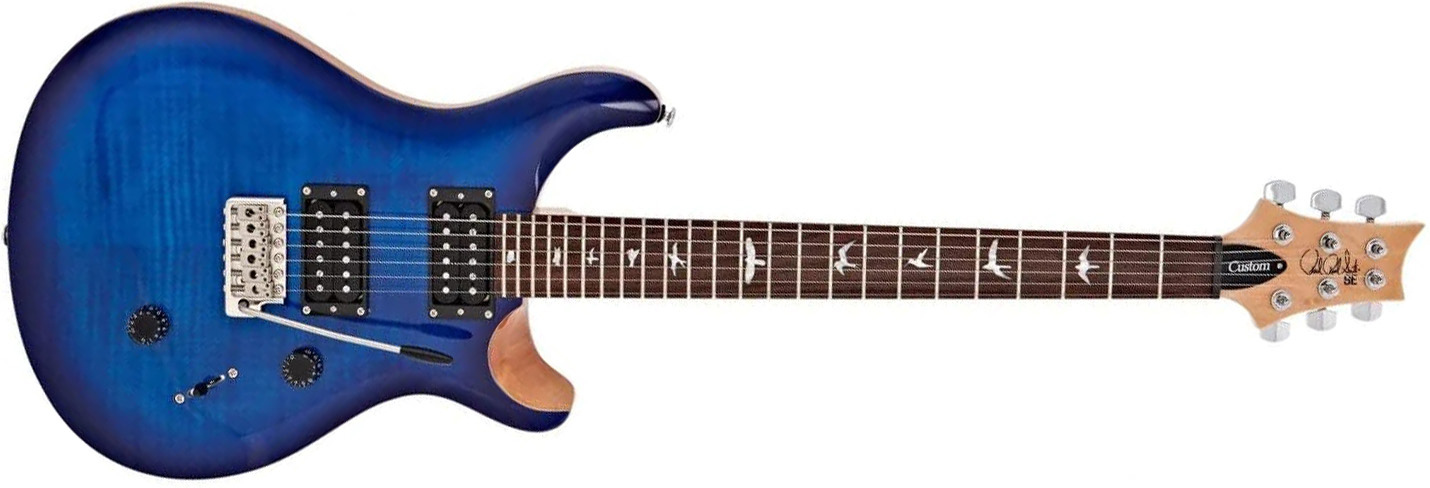
The product we’re discussing is the PRS SE Custom 24, which comes in a visually striking faded blue burst color.
Built for music enthusiasts, this solidbody electric guitar is primarily made from Mahogany wood, known for its durability and resonance.
The impressive Faded Blue Burst finish isn’t the only thing that stands out. The guitar also features a high-quality Maple neck and beautiful Rosewood fretboard.
Furthermore, the top material is composed of a harmonious combination of Maple, Rosewood, and Mahogany wood, delivering a rich, warm tone.
Indeed, the neck is Maple which ensures stability, and the fretboard is Rosewood which delivers a smooth, easy playability.
One of the guitar’s striking features are its 2 Humbucking pickups, allowing for a wide range of sound capabilities.
Additionally, the guitar is equipped with a Tremolo, another interesting feature that offers more tonal flexibility.
The strings are made of a strong Nickel material that can withstand long periods of play.
Lastly, this guitar is designed with a right hand orientation, ensuring comfortable play for right-handed musicians.
The PRS SE Custom 24 in Faded Blue Burst is not just visually appealing, but also boasts a variety of high-quality features and materials that make it a valuable asset to any guitarist’s collection.
- My Review
Upon unpacking the PRS SE Custom 24 Faded Blue Burst, the stunning design is instantly apparent.
Its solid mahogany body encloses superior craftsmanship with a compelling faded blue burst finish.
The maple neck gives it a remarkable hand feel, a crucial factor for any guitarist.
Furthermore, I found the rosewood fretboard delightful and smooth, with no fret buzz detectable upon playing.
With the iconic combination of two humbucking pickups, one can explore a multitude of tones from deep and rich to bright and crisp.
Where the instrument really shines is its ability to switch from humbucker mode to single coil via its push-pull tone pot.
Engaging this feature instills the guitar with sweet, sparkling tones that would remind any guitarist of traditional Stratocasters and Telecasters.
However, the guitar is not without its small caveats.
I was a tad surprised to find the action set relatively high, a bit contrary to what one might anticipate from a factory-set guitar.
While not a deal breaker, it does indicate that some minor adjustments may be required to suit individual playing styles.
The intonation also needed a touch of tweaking, as a few strings ran surprisingly sharp.
That being said, once these corrections were made, the guitar performed admirably.
The mahogany body contributes to a deep, warm and resonant tone that is perfect for blues, jazz, rock, and more.
The tremolo, yet another impressive feature, runs smoothly ensuring you can dive, dip and swoop without fear of detuning the instrument.
Despite the minute blemishes, which most factory-made guitars inevitably have, the build quality of the guitar remains impressive.
From the comfortable bridge to the excellent weight balance and the robust push-pull pot, it unquestionably asserts itself as a premium instrument.
The guitar’s edge is clearly defined, and the binding well executed, displaying the meticulous attention to detail exerted during its construction.
Looking beyond the superficial, the PRS SE Custom 24 truly is a superior choice for both hobby and professional guitarists, offering unparalleled quality, versatility, and delightful playability, all at an exceptional value.
- Pros:
- Great build quality
- Comfortable design
- Good pickup sound capability
- Cons:
- Possibility of minor blemishes
- Action may be set high
- Potential intonation issues
My final verdict is that the PRS SE Custom 24 Faded Blue Burst is an exceptional instrument worth its price.
Its solid mahogany body and maple/rosewood combo provide superb resonance and sustain, important for any serious guitarist.
The two humbucking pickups offer a wide range of tonal possibilities, making it a versatile guitar for nearly any genre.
The high-quality materials and excellent craftsmanship guarantee a reliable, enduring instrument.
This guitar is a perfect choice for both professional and aspiring musicians.
Fender Vintera 70s Deluxe Telecaster Electric Guitar
Vintage-style Telecaster with powerful, authentic sound.
Equipped with two wide-range humbucking pickups, this electric guitar delivers the bold, punchy tone that made Fender’s Golden era famous. Its slim C-shaped maple neck and 21 vintage-style frets offer a classic playing feel, while the vintage-style string-through body tele bridge with three chrome barrel saddles ensures accurate intonation. Additionally, it comes with a deluxe gig bag for secure storage.

This Fender Vintera 70s Deluxe Telecaster Electric Guitar comes in an appealing Mocha color, with a maple fingerboard adding to its aesthetic appeal.
It boasts a pair of wide-range humbucking pickups that have been redesigned to closely mimic the originals.
The guitar features a body made in the style of Alder, designed to provide depth and richness in sound.
It comes with a vintage-style string-through-body Tele bridge fitted with three chrome barrel saddles for authentic sound.
For ease of transportation, it includes a deluxe gig bag.
The slim “c”-shaped maple neck and 7.25”-radius fingerboard furnished with 21 vintage-style frets contribute to the classic playing feel.
Its attributes catering to hand orientation specifies the guitar to be ideal for right-handed players.
The design also features nickel steel strings for resilience and long-lasting performance.
Lastly, to align with classic aesthetics, this Telecaster features vintage-style strap buttons, chrome hardware, and an “f”-stamped tuning machine, assuring not only a vintage look but also a rock-solid tuning stability.
- My Review
After carefully analyzing and thoroughly experiencing the Fender Vintera 70s Deluxe Telecaster Electric Guitar, I have a considerable amount of thoughts to share.
First off, an aspect I valued greatly is the authentic Vintage Style and unmatched sound quality this guitar brings, making it a classic homage to Fender’s golden era.
One of the main features that particularly captured my attention was the effective neck profile and its playing feel, providing comfortability even during long playing sessions.
A top-notch attribute to mention as well is the wide range humbucking pickups, they are re-voiced to sound just like the originals—offering a punchy tone that simply strikes the right chords in one’s heart.
An intriguing aspect to note is the guitar’s construction, comprised of a sturdy alder body detailed with a maple neck and fingerboard. This combination not only lends to aesthetic pleasure, but it handles well, feels solid and shows resilience over time.
Moreover, the functionalities that come inbuilt within the guitar are impressive, this includes a vintage-style string-through-body bridge with three chrome barrel saddles that ensures accurate guitar intonation
On a similar note, the presence of “F”-stamped tuning machines provides a great era-appropriate aesthetic and adds to the rock-solid tuning stability.
However, everything is not roses; I came across some minute quirks.
I found slight issues related to the tone knobs and the input jack, which have lead to interference and caused the sound to cut in and out on rare occasions.
Additionally, the seemingly minor issue with the width of the nut on the 1st string has been quite a letdown—it cannot accommodate the suggested size strings and hence impacts the instrument’s performance.
Despite these minor setbacks, these issues are quite solvable and does not take away from the amazingness of this product.
It’s also worth mentioning that this guitar comes with a deluxe gig bag—which serves as a nice added bonus.
From my experience, the Fender Vintera 70s Deluxe Telecaster Electric Guitar stands as a testament to the classic aesthetics, quality build, and reliable performance of Fender’s vintage designs; it’s surely a worthwhile investment for any serious guitarist.
- Pros:
- Great sound and playability.
- Stays in tune well.
- Included deluxe gig bag.
- Cons:
- Potential interference issues.
- May need setup out of the box.
- Possibly defective pickups.
My final verdict is that the Fender Vintera 70s Deluxe Telecaster Electric Guitar is an amazing choice for those seeking vintage style and sound.
It showcases true authenticity to Fender’s golden era with its re-voiced pickups and period-accurate neck profile.
The guitar comes with extra features such as vintage-style strap buttons, chrome hardware and three-bolt neck plate.
Whether you are an aspiring musician or a professional one, this guitar with its bold and fat-sounding humbucking pickups will reignite your passion for music.
It offers great value for the price, wrapping up performance, aesthetics and nostalgia in one package.
ESP LTD EC-1000 Electric Guitar
Premium material, rich tone, stunning purple sunburst finish.
This electric guitar has a solidbody with a mahogany body, a mahogany neck, and a maple top; all contributing to excellent sound quality. The unique See Thru Purple Sunburst color enhances its looks. Fitted with two humbucking pickups, a hard tail guitar bridge system and six strings, it provides outstanding performance and comfort.
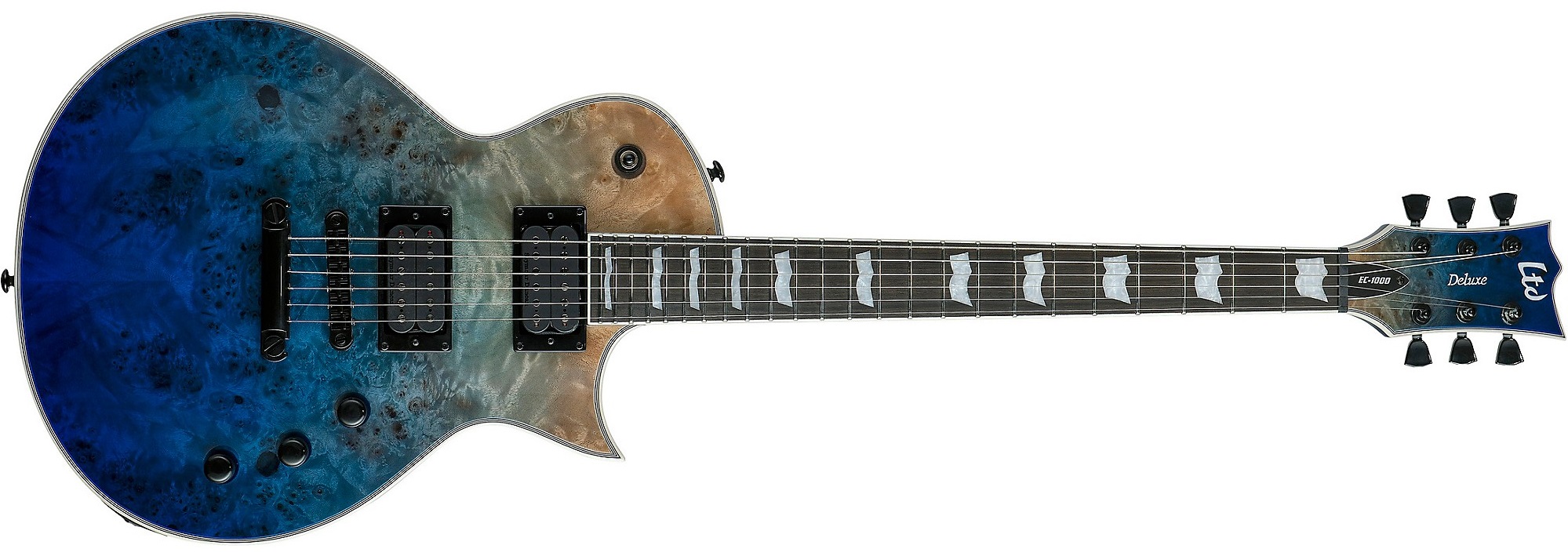
If you haven’t seen the ESP LTD EC-1000 Electric Guitar, it’s definitely something you want to check out.
This electric embodiment of sound comes in a stunning See-thru Purple Sunburst color, making it visually entrancing.
What makes this guitar special is its blend of different woods – maple, mahogany, and ebony.
It boasts a solidbody derived from maple and mahogany, giving it a sturdy feel yet a light touch.
The ebony fingerboard contrasts subtly with the mahogany neck and maple top, enhancing not just its appearance but playing comfort as well.
The guitar’s back comprises of the same materials used in the body – maple and mahogany, ensuring consistent resonance and balance.
Similarly, the mahogany themed layout extends into the neck and fretboard.
There are 2 humbucking pickups that add to the guitar’s powerful sound output, making it a beast in terms of performance.
The hardtail guitar bridge system ensures stability and increases sustain, offering a massive advantage in maintaining tune stability for longer playing sessions.
And of course, being an electric guitar, it comes with the standard 6 strings.
Produced by the renowned brand ESP, this guitar indeed promises a mix of looks, tone, and feel.
- My Review
When I first laid eyes on the ESP LTD EC-1000 Electric Guitar, the stunning ‘See-thru Purple Sunburst’ color immediately caught my attention.
Apart from its aesthetic appeal, I was quickly drawn towards its build quality; the solid maple and mahogany body exudes a premium feel and lends significant heft to the ESP LTD EC-1000.
I was also quite impressed by the immaculate craftsmanship of the maple top – it adds a sharp and crisp characteristic to the sound profile.
Plucking the strings, the two humbucking pickups are instantly noticeable in their delivery of a broad range of tones—excellent for various musical genres.
Hats off to the engineers, as it doesn’t compromise on the natural, rich sound that emanates from the combination of maple, mahogany, and ebony wood in the guitar’s body and construction.
Talking about the fretboard, the mahogany wood ensures a smooth, unhindered slide, which, as a guitar player myself, I can say is of utmost importance.
Plus, the sleek mahogany neck is well-made; it’s comfortable to grip, making it less strenuous to pull off complex chords or solos, especially during long practice sessions.
The feature that genuinely distinguishes ESP LTD EC-1000 from others in its category is the hard tail guitar bridge system.
This system, unlike the usual vibrato or tremolo systems, enhances tuning stability and makes string changes less of a hassle.
Being a six-string electric guitar, it invites both rookies and seasoned players who love to experiment with different music styles.
After spending ample time with this electric guitar, I must say, the ESP brand has lived up to its reputation with the LTD EC-1000.
However, there’s always room for improvement; I believe a coil-split feature would have been a valuable addition, as it would provide the player with more tonal options.
On the whole, the ESP LTD EC-1000 Electric Guitar is a delightful blend of beauty, robustness, and excellent sound quality.
This guitar doesn’t only cater to your musical needs but also adds flair to your performance with its vibrant color and elegant design.
Despite a minor shortcoming, it’s safe to say that this guitar is indeed a significant investment for any aspiring or professional musician.
- Pros:
- High-quality build materials.
- Amazing see-through purple sunburst color.
- 2 Humbucking Pickups for diverse sound range.
- Cons:
- May be pricey for some buyers.
My final verdict is that the ESP LTD EC-1000 Electric Guitar is a remarkable instrument.
Thanks to its solid build quality and the choice of woods used for the body, neck, and fretboard, it delivers an incredible tone.
Its See Thru Purple Sunburst not only looks stunning but also enhances the overall user experience.
Despite its higher price point compared to other guitars, its outstanding features, looks, and performance justify the investment.
This guitar is definitely a highly recommended choice for both beginners and seasoned players.
Yamaha Revstar Standard RSS20 Electric Guitar
Versatile sound with enhanced tone and balance.
Featuring a carbon-reinforced neck and a chambered body constructed from maple and mahogany, this electric guitar from Yamaha combines modern design with vintage craftsmanship. The guitar’s set of Alnico V humbucking pickups, 5-position pickup selector, and a passive push/pull Focus Switch offer versatile sound options. A deluxe gig bag is provided, with left-handed models available on the market.
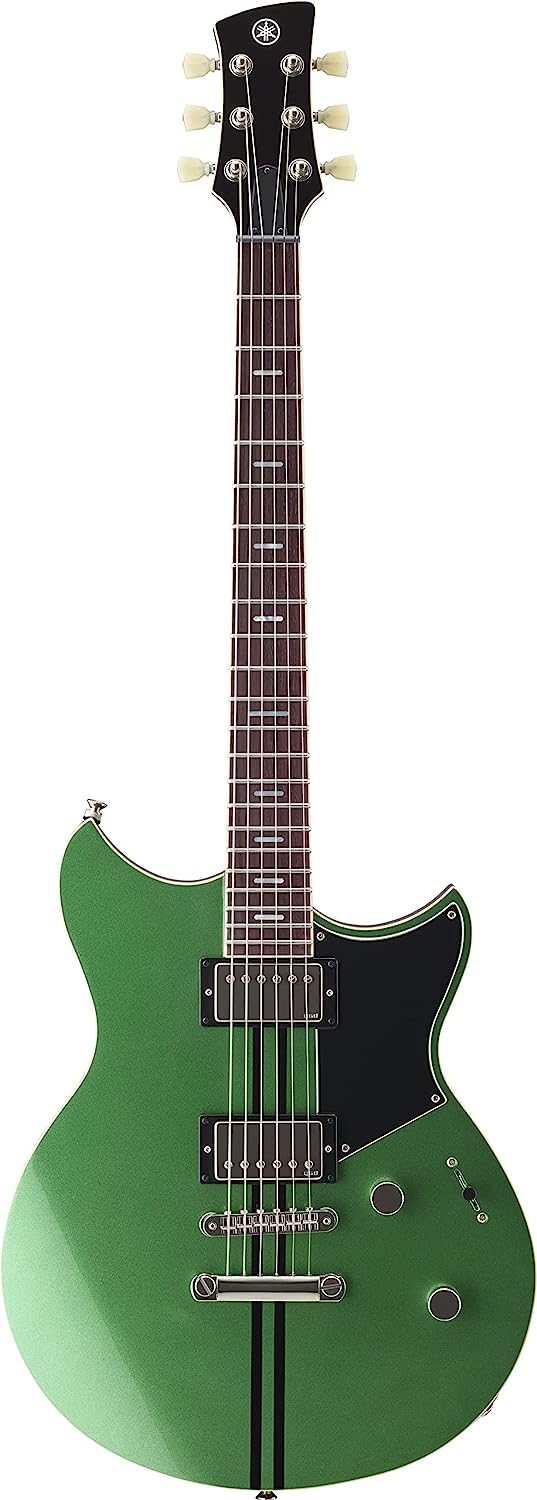
Here, we have an electric guitar from the renowned musical brand, Yamaha. It’s from their Revstar Standard series and goes by the sweeping name of RSS20.
Now, what makes this guitar stand out is its vivacious flash green color. It instantly catches your eye, doesn’t it?
What’s more, this guitar proudly boasts a body made from a duo of chambered maple and mahogany, lending to its aesthetic and acoustic qualities.
The guitar isn’t just pretty, as functionally too, it shines. Its neck, a 3-piece mahogany ensemble, is reinforced with carbon which adds to its strength and durability.
Once you strum the strings, you’ll find the RSS20 equipped with two Alnico V Humbucking pickups. This ensures that the guitar generates an excellent sound output.
In addition, the 5-position pickup selector allows you to play a diverse range of tunes. After all, isn’t variety key in music?
Appreciate the guitar’s personality with its Right-hand orientation, Rosewood fretboard and Coated Steel strings. Plus, if you are a lefty, don’t worry! Yamaha has thoughtfully created a left-handed model, the RSS20L, too.
Crowning off, this FGR model comes bundled with a deluxe gig bag that looks fabulous and is genuinely handy for carrying around your guitar safely.
- My Review
As someone who values the build quality and aesthetics of a guitar, I can attest that the Yamaha Revstar Standard RSS20 FGR brings a rich, resounding color and style to the game.
The Flash Green finish is just beautiful, giving it a unique edge that stands out among its competitors.
Further adding to the guitar’s distinct look, this model boasts a chambered maple and mahogany body which offers a unique sound.
What is more, the three-piece mahogany neck has been reinforced with carbon, an additional detail that vastly improves the instrument’s durability over the long run.
Moving from the look to the sound, the guitar is equipped with Alnico V Humbucking pickups, which notably leans towards jazzy tones but still allows for a roaringly wide range of sound, letting you tap from angelic voices to demonic screams and everything in between.
This excellent sound versatility is further enhanced by the 5-position pickup selector and the passive push/pull Focus Switch, granting players unprecedented control and versatility.
In terms of playability, the action is effortless—like sliding butter across a hot pan.
Even the challenge of jumbo frets is smoothly overcome with a short acclimation period.
And while we’re on the topic of smooth, let’s talk about the guitar’s stability in tuning.
No matter how hard the jam session, this guitar holds its tune with impressive consistency, making for an uninterrupted musical performance.
Though the guitar comes with a deluxe gig bag, I have to admit, this isn’t just any guitar that you’d want to chuck carelessly into a bag.
Instead, the Yamaha Revstar Standard RSS20 FGR commands respect and reverent handling, even when transporting.
While strings are often a matter of personal choice, coated steel—which is provided with this guitar—tends to offer a great blend of durability and warm, balanced tone.
Lastly, and this cannot be emphasized enough, left-handed players need not miss out on this guitar’s greatness, as a left-handed model is also available—this truly is an all-inclusive instrument.
So if you’re wondering whether you should give this Yamaha model a try, I’d say I didn’t just like it—I loved every strum, every note, and every riff.
In playing the Yamaha Revstar Standard RSS20 FGR, I rediscovered the joy of finding new tones, pushing the boundaries, and simply letting the music flow through me.
- Pros:
- Excellent build quality.
- Uncommon versatility in sound.
- Incredible resonance and sustain.
- Cons:
- Jumbo frets may take getting used to.
My final verdict is that the Yamaha Revstar Standard RSS20 FGR Electric Guitar stands out as one of the high-quality, versatile musical instruments in the market.
With its unique chambered maple and mahogany body, and carbon-reinforced 3-piece mahogany neck, this guitar guarantees an enhanced tone and optimal balance.
The incorporated Alnico V Humbucking pickups combined with the 5-position pickup selector ensure you achieve a wide variety of sounds, suitable for different genres of music.
Additionally, the provision of the deluxe gig bag offers an effective way of carrying and protecting the guitar against damages.
In a nutshell, from a professional point of view, this guitar deserves a recommendation for someone looking to invest in a durable, versatile, and high-performance guitar.
Gibson Les Paul Standard ’50s P90 Electric Guitar
Classic design with premium-quality materials and electronics.
The electric guitar is a tribute to Gibson’s golden era, featuring a golden top and a solid mahogany body with maple. It comes equipped with classic P-90 pickups, vintage deluxe tuners and an ABR-1 Tune-O-Matic bridge. Its authentic design includes a 50’s style mahogany neck with a rosewood fingerboard and trapezoid inlays.

Gibson presents the Les Paul Standard ’50s P90 Electric Guitar, boasting a visually stunning gold finish.
Sticking true to traditional crafting, it makes use of a mix of rosewood, mahogany, maple wood and metal in its build, underscored by an exceptional gold finish.
This guitar is designed with a right-hand orientation and features a mahogany neck and a fretboard made of rosewood.
Notably, the electric guitar is equipped with an ABR-1 Tune-O-Matic bridge, aluminum stop bar tailpiece and vintage deluxe tuners.
The signature P-90 pickups (for both neck and bridge positions) are loaded with AlNiCo V magnets, audio taper potentiometers and orange drop capacitors.
Specifically, the guitar setup includes a mahogany body coupled with a maple top and a vintage 50s-profile neck.
The guitar’s thickness has not been compromised due to any “weight relief” – indicating it uses solid wood construction throughout.
The neck is made of mahogany and comes with a scale length of 24.75 inches, finished with gloss Nitrocellulose Lacquer.
The Les Paul Standard ’50s features a rosewood fingerboard with a radius of 12 inches, complete with acrylic trapezoid inlays.
Taking this guitar home, you will also receive a Gibson Accessory Kit packed in a robust hard-shell case.
- My Review
As a devout follower of Gibson’s Golden Era creations, I find the Gibson Les Paul Standard ’50s P90 Electric Guitar – Gold Top, a captivating model that truly personifies tradition.
Brimming with a sense of authenticity, it pays a visceral tribute to its lineage with a classic design.
The guitar’s solid mahogany body is a clear testament to Gibson’s unparalleled craftsmanship, encased in a glossy gold top that adds to the grandeur.
I found myself truly fond of the ezquisitely crafted maple top, a stunning contrast to the mahogany body, radiating a bold charm.
Real rosewood is what makes up the fretboard, providing both an aesthetic and acoustic edge to the instrument.
The pronounced effect of the guitar’s sound quality is clearly attributable to the hand-wired AlNiCo V magnets with audio taper potentiometers and orange drop capacitors.
As an aficionado, I couldn’t help but admire the P-90 pickups nestled comfortably at the neck and bridge, fostering myriad hues of tones that are distinctly unique.
Complementing the vintage deluxe tuners with keystone buttons, the ABR-1, the classic-style Tune-O-Matic bridge, and aluminum stop bar tailpiece, further enhances the nostalgia tied to this instrument.
Fit for right-handed musicians, the strings of this guitar are made of resilient nickel, which I observed has a significant impact on the pitch and tone.
While the mahogany neck is designed in a rounded 50’s-style, the comfort it offers is without question, adapting to my grip smoothly and naturally.
The rosewood fingerboard, adorned with trapezoid inlays, provides that quintessential ’50s vibe, taking me back in time with every strum.
Despite its iconic design, it’s the details like the aged gold top hat knobs that distinguish this model, making it a classic Gibson through and through.
Remarkably enough, the guitar comes encased in a hard shell case, which adds a layer of protection, making it suitable for long hauls and vigorous performances alike.
With its rich sound quality, timeless design, and superior craftsmanship, the Gibson Les Paul Standard ’50s P90 Electric Guitar – Gold Top, for me, is a testament to Gibson’s legacy and its unwavering commitment to quality.
- Pros:
- Classic Gibson ’50s design.
- High-quality mahogany and maple materials.
- Includes Gibson Accessory Kit.
- Cons:
- May be too heavy for some.
- May not suit all musical styles.
My final verdict is that the Gibson Les Paul Standard ’50s P90 Electric Guitar – Gold Top is an excellent blend of vintage aesthetics and modern performance.
It delivers rich and warm tones that the classic P-90 pickups are revered for, providing a truly satisfying playing experience.
The quality and craftsmanship of the guitar is outstanding, staying true to Gibson’s reputation.
The attention to detail and the faithful recreation of the iconic 50s Les Paul design makes it a must-have for any Gibson fan.
If you’re looking for a guitar that sounds as good as it looks, you can’t go wrong with this one.
PRS Guitars SE McCarty 594 Electric Guitar
Versatile vintage-inspired guitar with unique tonal capabilities.
Equipped with volume and push/pull tone controls, the guitar offers distinct humbucking and single-coil tones for versatile play. It features a bound 22-fret Pattern Vintage neck, a slightly thicker back for sustainable sound, and classic bird inlays. Made with top quality materials like mahogany and maple, and includes a two-piece bridge and gigbag for portability.
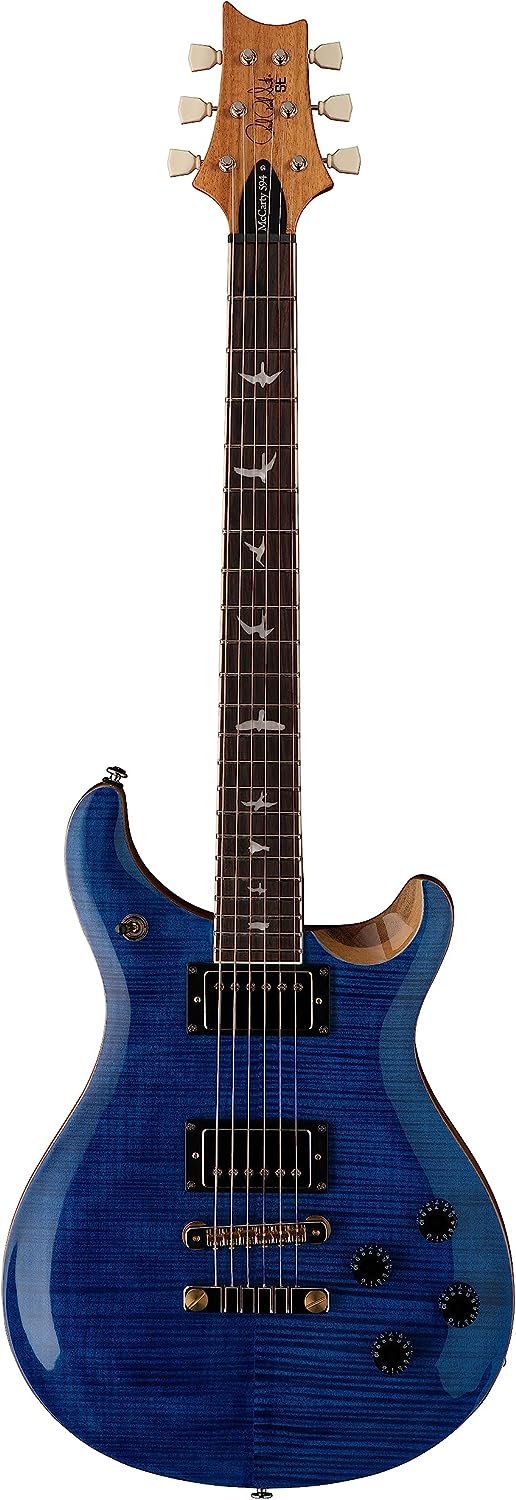
As an addition to an already well-defined guitar range, the PRS Guitars 6 String SE McCarty 594 has the reputation of being a reliable, roadworthy instrument with its faded blue color adding to its aesthetic appeal.
It boasts volume and push/pull tone controls, applicable to each pickup, enhanced with a 3-Way Toggle Switch on the Upper Bout, offering a wide spectrum between humbucking and single-coil tones.
Shaped in the iconic PRS form, it houses bird inlays which subtly introduce a modern touch to its classic set of features.
Included is a bound 22-fret Pattern Vintage neck and a thicker back designed for optimal sustain.
It is centered around a PRS Two-Piece Bridge making it the heart of this guitar.
The material composition includes Maple for the body, Mahogany for the top material, back and neck, and Mahogany Wood for the fretboard, all merged to create its unique character.
The guitar sports an S-S pickup configuration for diversified sound options.
To ensure compatibility with right-handed players, it has a right-hand orientation.
The guitar resonates with 58/15 LT “S” pickups which are engineered to emit warm, vintage-inspired tones with a clear and sweet edge.
Safeguarded by a zinc two-piece bridge and vintage-style tuners, this instrument stays faithful to delivering a vintage experience.
- My Review
My impressions of the PRS Guitars 6 String SE McCarty 594 begin with the outstanding craftsmanship that is evident from the first strum.
I’m drawn in by the aesthetic beauty of this faded blue guitar, with its classic PRS body shape, and bird inlays setting it apart from run-of-the-mill models.
The versatility of this instrument is remarkable, effortlessly combining humbucking and single-coil tonal landscapes due to its intelligent volume and push/pull tone controls.
For me, perfecting nuance in my sound palette is vital, and the SE McCarty 594 caters wonderfully to this, as it hosts the carefully designed 58/15 LT “S” pickups.
These particular pickups breathe a warm, vintage-inspired tone into your playing and offer an attractive blend of clarity and sweetness.
The guitar also possesses a bound 22-fret Pattern Vintage neck and a slightly chunkier back which, to my delight, noticeably aids in added sustain.
Should you, like me, value tradition in your guitars, the zinc two-piece bridge and vintage-style tuners stay true to the vintage promise that the PRS SE McCarty 594 has at its heart.
Using mahogany wood for the top, back, neck, and fretboard material is a horizon-expanding experience for any player, offering a depth and resonance typically associated with higher-end, professional-grade guitars.
Maple is the choice for the guitar’s body, contributing to the overall tonal balance and enhancing the aesthetic charm.
Right-handed players will appreciate the thoughtful design that has gone into the hand orientation.
The PRS gig bag that accompanies this guitar is a welcome accessory, making transport easier and providing an added layer of protection for your new musical partner.
Though the guitar features an S-S guitar pickup configuration and brass strings, it caters to a diverse array of tones and playing styles, from crystal clear, ringing notes to harmonic-laden rock riffs.
In playing the PRS Guitars 6 String SE McCarty 594, I feel a touch of modernity blend with the best of classic guitar design, which truly sets this instrument apart.
It embodies the timeless allure of vintage guitars, with an infusion of modern design elements, making it a beautiful and high-performing instrument that satisfies on both the aesthetic and musical fronts.
- Pros:
- Versatile and vintage-inspired instrument.
- Offers both humbucking and single-coil tones.
- Included gig bag for convenience and protection.
- Cons:
- Faded blue color might not appeal to all.
- Slightly thicker back might not fit all playing styles.
My final verdict is that the PRS Guitars 6 String SE McCarty 594 is an exceptional instrument that lives up to its promise of vintage-inspired versatility.
Its dual volume and push/pull tone controls ensure a wide range of sonic possibilities, catering to all styles of playing.
The 58/15 LT “S” pickups deliver a warm tone with remarkable clarity that will undoubtedly appease enthusiasts of a more traditional sound.
Furthermore, the high-quality build and materials – from brass strings to mahogany fretboard – ensure this model is built to last.
In a nutshell, I believe the SE McCarty 594 is a solid investment for any serious guitar player looking for a blend of classic and modern features.
Fender Player Jaguar Electric Guitar
Uniquely slinky feel inspires new musical creativity.
This electric guitar features a gloss-finished alder body with a modern “C”-shaped neck profile and a 9.5″-radius fingerboard. It comes with a Player Series humbucking bridge pickup and a single-coil Jaguar neck pickup, offering unique sound and tonalities. Stylish chrome accents and a slinky playing feel make this guitar ideal for those looking to try new chords and melodies.
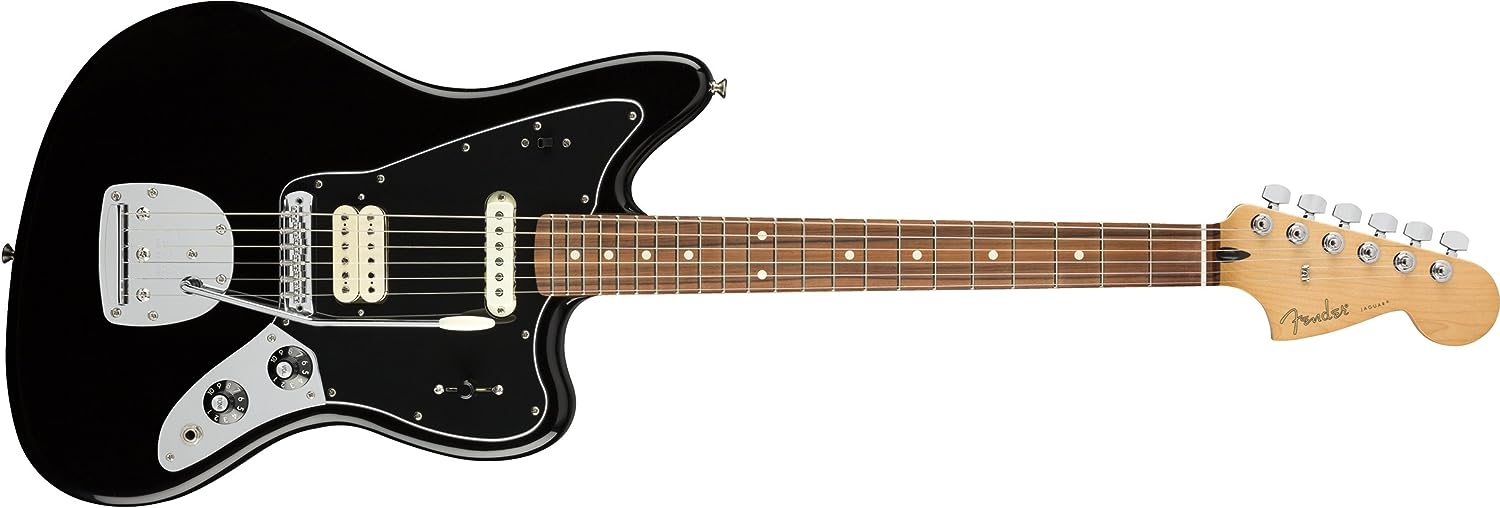
The Fender Player Jaguar Electric Guitar is a stylish instrument that features a smooth, sleek black body made entirely of high-quality alder.
In terms of pickup configuration, this guitar comes with a Player series humbucking bridge pickup and a single-coil Jaguar neck pickup, offering a unique blend of modern and classic sounds.
The guitar also houses a coil-split humbucking bridge pickup that can be activated via a slide switch, providing players with added versatility in sound development.
Featuring a modern “C” shaped neck profile, the guitar lends itself to easy and comfortable play, especially given its 9.5″ radius fingerboard.
The fingerboard, crafted from Pau Ferro, is a testament to the Fender’s commitment to quality.
Apart from these, the guitar has nickel steel strings and includes a tremolo bridge system which contributes to its unique sound quality.
The guitar, designed for right-handed players, truly shines under the spotlight with its eye-catching chrome accents.
The Fender Player Jaguar Electric Guitar encourages explorative playing, serving as an inspiration for artists to discover new chords, melodies, and sounds.
Indeed, it is this unique blend of classic and modern features that makes the Fender Player Jaguar an instrument capable of inspiring brand new music genres.
- My Review
As I picked up the Fender Player Jaguar Electric Guitar, I was immediately struck by the sleek design and high gloss black finish.
The guitar has a uniquely slinky playing feel, which stimulated me to experiment with diverse chords and melodies.
What truly captivated me though, was the distinct sound, a modern spin on classic Fender tone, which inspired creativity and added substance to my music.
One of the key features of this guitar that caught my attention was the Player Series humbucking bridge pickup and a single-coil Jaguar neck pickup, creating a balance between vintage and contemporary sounds.
I was also impressed with the coil-split humbucking Bridge pickup that could be toggled via a slide switch, offering a range of tonal versatility.
Definitely worth noting, is the Pau Ferro fingerboard which felt comfortable as my fingers slid over the frets with each chord progression I explored.
Nickel Steel strings and a modern C-shaped neck profile provided an excellent feel and smooth action.
However, I noticed that the guitar required some minor adjustments.
The low E string, for example, had a subtle but noticeable buzz that required rectification.
Also, it became apparent that the bridge pickup was placed a tad too far from the strings and resulted in reduced volume, something that needed attention.
Despite these minor setbacks, a few tweaks and the beautiful sound of this guitar were restored.
While this guitar has some minor flaws, they are far outweighed by its superb sound and feel.
With striking chrome accents, this guitar is not just an instrument but a spotlight-ready piece that will elevate any performer’s stage presence.
Constructed with an Alder body, the guitar has a solid feel and surprisingly lightweight, allowing for hours of comfortable play.
In reflection after my hands-on experience, I view the Fender Player Jaguar electric guitar as a musically inspiring and visually pleasing instrument, bound to satisfy any guitarist’s discerning tastes, despite requiring a bit of personal tuning and adjustment.
This guitar is more than just an instrument, it’s a catalyst for artistic creativity and experimentation, a gateway to new sounds and musical landscapes.
- Pros:
- Great sound and feel.
- Stunning color options.
- Smooth guitar action.
- Cons:
- Quality check issues on delivery.
- Some found the neck slightly off axis.
- Reported buzzing from low E string.
My final verdict is that the Fender Player Jaguar Electric Guitar is a highly versatile and accomplished instrument.
It’s unique playing experience pushes you to experiment with your music, encouraging creativity.
The chrome accents are not only aesthetically pleasing but also functionally effective.
With its affordable price and high-quality build, it is an excellent choice for both beginners and seasoned musicians.
The authentic sound and feel is certain to inspire you to reach new musical horizons.
Squier J Mascis Jazzmaster Electric Guitar
Dinosaur Jr. endorsed, vintage-style, high-performance electric guitar.
This electric guitar sports a C-shaped maple neck and 21-fret rosewood fingerboard, with two single-coil Jazzmaster pickups and an adjusto-matic bridge. It’s designed with a dual-circuit for lead and rhythm, each with its own volume and tone controls. Made to the specs of Dinosaur Jr leader, J Mascis, the model delivers massive sound and performance.

Take a look at the Squier J Mascis Jazzmaster, it’s an exceptional electric guitar brought to you by Fender.
It boasts a distinct vintage white color that is certainly eye-catching.
Made up of a Basswood body, the construction is both solid and lightweight, offering an ideal balance for players looking for comfort and durability.
It also houses an Adjusto-Matic bridge paired with a vintage-style “floating” tremolo tailpiece.
Two unique single-coil Jazzmaster pickups are adopted into this design, ensuring a warm and rich sound.
Impressively, it features a dual-circuit design, offering “lead” and “rhythm” options complete with independent volume and tone controls for each.
The J Mascis Jazzmaster also comes with a warranty, providing added security for your investment.
This electric guitar dresses a maple neck which comfortably fits into your hands and an easy-to-play 21-fret Laurel fingerboard.
Fascinatingly, J Mascis himself specified the pickups, hardware, and finish, ensuring immense value and astounding tone.
The signature of J Mascis is proudly displayed on its headstock, which showcases the quality and mastery behind this instrument.
So, whether you’re an alt-rock fan or an eclectic musician, this guitar delivers colossal sound and top-notch performance.
- My Review
Delving into the sonic marvels of this electric guitar, I must state that the Squier J Mascis Jazzmaster emits tones that are both crisp and powerful.
Equipped with two single-coil Jazzmaster pickups, the tonal range it offers is truly commendable.
I was particularly struck by the dual-circuit design of “lead” and “rhythm”, which allows banging solos and chill strumming.
One of the things that stood out to me is the Adjusto-Matic bridge which, along with the vintage-style “floating” tremolo tailpiece enhanced the guitar’s playability.
However, I faced a few hiccups with the G string not resting in the neck nut, which became a slight frustration when playing.
Fixable indeed, but I expected ideal tuning stability right out of the box.
An element that I adored is the C-shaped profile of the maple neck along with the 21-fret rosewood fingerboard.
The tactile experience was quite comfortable, unlike some instruments that can feel awkward in one’s hands.
Something that could be improved though, is the routing of the neck pocket; it appeared to have been done slightly sloppily and seemed inconsistent.
As for the aesthetics, the Vintage White color makes the guitar ooze retro vibes, and definitely makes it a visual treat.
While the basswood body contributes to a well-balanced tone with rich lows and crisp highs, aiding the overall sonic experience.
But it wasn’t just the sound that won me over; the durability of this instrument is hard to deny!
With a strong maple neck and sturdy body materials, this is an instrument that would likely withstand the rigors of frequent gigging or touring.
One thing that struck me as odd was the guitar arriving without sound; perhaps an issue on the manufacturing side.
However, a quick fix swiftly resolved this and I was jamming away, relishing the sonic prowess of this beautiful beast.
What makes this guitar even better, is the comfort of having a warranty included, ensuring peace of mind for any musician.
All things considered, the Squier J Mascis Jazzmaster is a must-have for anyone looking to explore the raw power of electric guitars with a vintage twist.
- Pros:
- Outstanding craftsmanship.
- High-quality pickups.
- Comfortable playability.
- Cons:
- Possible issues with neck nut.
- May require additional setup.
- Occasional quality control problems.
My final verdict is that the Squier J Mascis Jazzmaster Electric Guitar stands as an embodiment of fantastic sound and quality craftsmanship.
From the maple neck with a C-shaped profile to the 21-fret rosewood fingerboard, every ounce of this instrument screams perfection in detail.
The two single-coil Jazzmaster pickups and classic dual-circuit design provide a symphony of tone versatility, serving every player’s needs.
Endorsed by a rock legend like J Mascis itself, it’s no surprise that the performance and robust sound delivery meet such high standards.
This guitar is undoubtedly a value-for-money option for every passionate guitarist out there.
Ibanez S670QM S Series Electric Guitar
Ibanez S670QM offers impressive palette of tone textures.
The electric guitar employs a Wizard III Maple neck and features a quilted maple top with a meranti body. The unique design includes a bound Rosewood fretboard, jumbo frets, and an Edge-Zero II tremolo bridge. Awarding a blend of different tone textures, the Ibanez humbucker pickup configuration ensures accurate tuning, even with extreme trem effects.

Ibanez’s S670QM S Series Electric Guitar is dressed in a stunning Sapphire Blue that immediately catches the eye.
Boasting a Wizard III Maple neck, it offers a comfortable and speedy playability that is a hallmark of Ibanez’s famed craftsmanship.
The guitar features a stunning Quilted Maple top, which acts as an aesthetic covering for the underlying mahogany body that has been chosen specifically for S Series guitars.
Not only lightweight to improve comfort, this guitar has a surprising heft that adds to the tone and sustain expected from the S Series.
The guitar’s fretboard is made from bound Rosewood, and showcases off-set white dot inlays while the jumbo frets enhance ease of play.
An Edge-Zero II tremolo bridge is also part of the guitar’s features, providing flawless tuning accuracy even when performing radical tremolo effects.
The make-up of the pickup configuration is simple but impressive: a unique combination of Ibanez humbucker, single-coil, humbucker that delivers an interesting range of tone textures.
This electric guitar is designed for left-handed players.
The material types used for different parts contribute to its standout features: Maple wood for the top, Meranti for the body and back, and Rosewood for the fretboard.
Although the carrying case is not included, it is sold separately. In all, the Ibanez S670QM S Series Electric Guitar is visually enchanting, comfortable to play, and offers a breadth of tone textures.
- My Review
Upon receiving the Ibanez S670QM S Series Electric Guitar, I was immediately enraptured by its exquisite sapphire blue tone, which indeed spruced up the aesthetics of my music room.
Running my hand over its silky quilted maple top, my fingers relished the seamless confluence of beauty and craftsmanship that was at display.
The wizard III maple neck added a touch of sumptuous elegance to the guitar that dovetailed beautifully with the overall look.
When I first strummed the strings, the sound was remarkably crisp and vivid, resonating perfectly against the meranti body.
The Edge-Zero II tremolo bridge facilitated a multitude of trem effects with incredible precision, allowing me to experiment and explore a wide array of sound dynamics and tunings which made my experience truly remarkable.
I found the fretboard of bound rosewood with off-set white dot inlay to be an absolute delight, providing me a swift and smooth performance.
However, the recessed 1/4″ jack with a small channel did pose a bit of an issue when I tried connecting my headphone amp, an anomaly I hope would be rectified in future models.
Though it took me some time to get accustomed to the floating tremolo, once I understood the mechanism, it was quite an impressive feature.
While the ceramic pickups have the potential to provide that crispy crunch that’s desirable for rock and metal, I did experience a slight problem in the A-string pickup being less responsive compared to the others which can be attributed to a minor manufacturing flaw that should not outweigh all the other spectacular features of this guitar.
What impressed me the most about this guitar were the Pretty hot ceramic pickups which offered an intoxicating crunch that is much desirable for rock and metal genre.
In terms of maintaining the guitar, the assembly might require some attention especially with regards to the nut which could use a Floyd Rose string tree for better tuning stability – a tip I strongly suggest for future owners.
My encounter with the guitar was not all smooth sailing as the action was slightly higher toward the bridge, necessitating me to adjust the neck – a minor inconvenience if you ask me.
Despite the hiccups, I firmly believe that its excellent sound quality and stunning aesthetics make the Ibanez S670QM S Series Electric Guitar Sapphire Blue a reliable and worthwhile investment for any music enthusiast.
- Pros:
- Impressive tone textures.
- Great for rock and metal.
- Comfortable Wizard III Maple neck.
- Cons:
- High learning curve for tuning.
- Possible set up required.
- Issues with tuning stability.
My final verdict is that the Ibanez S670QM S Series Electric Guitar fulfills its promise of combining aesthetics with functionality.
With the iconic Ibanez Wizard III Maple neck, players are promised a high level of playability, delivering both responsiveness and speed.
The humbucker, single-coil, humbucker configuration provides an impressive palette of tone textures, backed by the solid and reliable Edge Zero II tremolo bridge which facilitates the performance of radical trem effects with flawless tuning accuracy.
While a case would have been appreciated, the merits of the guitar itself make it a deserving acquisition for enthusiasts and professionals alike.
Gibson Custom ES-335 Electric Guitar
Gibson ES-335 offers versatile, full-bodied, classic tones.
This beautifully designed guitar harmonizes the design of solid body and hollow body guitars. It comes equipped with two ’57 Classic humbucking pickups, a thin-tapered 1960s neck and rosewood fretboard coupled with nickel-plated Grover tuning heads. Its blend of full-bodied growls and singing sustain make it a versatile choice for all styles of music.
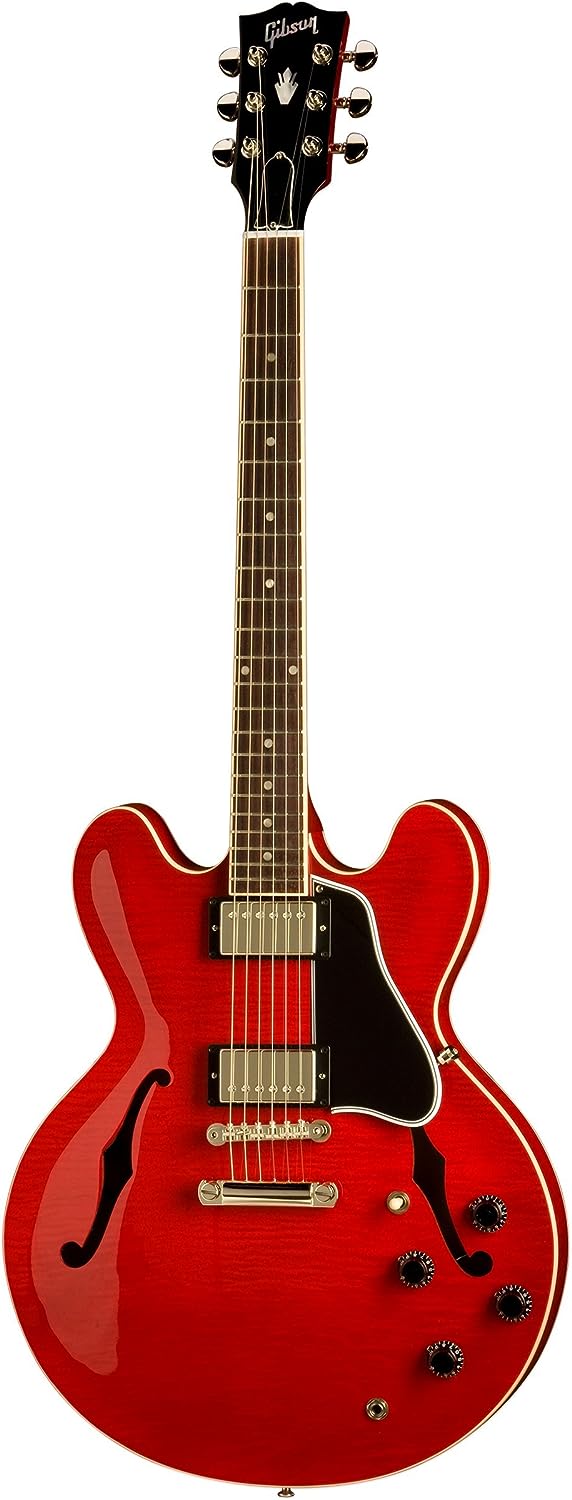
The Gibson Custom ES-335 Dot Electric Guitar elegantly fuses the best elements of solid and hollow body designs.
With its appealing figured maple and cherry finish, it is not only visually striking but also highly versatile in its sound.
It comes richly fitted with a rosewood fretboard and is adorned with beautiful mother-of-pearl inlays.
Constructed with a wooden body, a mahogany neck, and a rosewood back, it ensures both durability and excellent resonance.
The “H” guitar pickup configuration caters to a range of tones, making it ideal for various styles of music.
Furthermore, its right-hand orientation, nickel strings, and Tune-O-Matic guitar bridge system offer both comfort and superior control.
This Gibson guitar is equipped with a pair of ’57 Classic humbucking pickups, enabling it to deliver a warm, robust sound and a singing sustain.
Its thin-neck profile, reminiscent of 1960s models, and the 24-3/4″ scale of its fingerboard make this guitar a joy to play.
Additionally, it is worth mentioning that the hardware is nickel-plated and includes Grover tuning heads, volume and tone control knobs, and a 3-way pickup selector switch.
The Gibson Custom shop has also incorporated an ABR-1 Tune-O-Matic bridge with stopbar tailpiece into the design.
Lastly, its nitrocellulose finish, a Gibson signature, ensures not only an attractive look but also contributes to a purer tone and ease of repair.
- My Review
On trying the Gibson Custom ES-335 Dot Electric Guitar, it immediately grasped my attention with its unique design, blurring the lines between a solid body and hollow body guitar.
Built using materials of the most impeccable quality, such as maple wood and mahogany, it is clear that the manufacturers poured careful thought into every single detail, from construction to performance.
The cherry-colored, figured maple body of the ES-335 provides not only an appeal but also brings a touch of classic charm to the guitar.
Musically, I found the range of tones it can produce to be exceptional, covering everything from the mellow tones perfect for jazz to the full-throttle drive of rock music.
With its dual ’57 Classic humbucking pickups, its ability to produce a full-bodied growl to a singing sustain left me impressed.
A striking feature is its thin-tapered 1960s neck along with a rosewood fretboard, making it a joy to play for those long jam sessions.
In terms of comfort and playability, the hand orientation is perfect for right-handed guitarists, while the nickel-plated hardware ensures sustainability and durability.
While playing it, I noticed its versatile nature that can fit into essentially any music style ranging from funk to metal and of course blues, giving more credence to its reputation for covering nearly every musical genre.
Moreover, it facilitates easy plug-ins to tube amps, a feature that many musicians will appreciate, especially those who seek to explore different music arenas.
Despite all its strengths, Gibson’s ES-335 is not without its weaknesses, most notably its price, which may put it out of reach for budding guitarists.
However, there is no denying that the ES-335’s rich, full tone, and unequaled playability warrant this guitar’s place among the most versatile guitars on the market.
Whether it is recording sessions, gigs, or casual playing, it has the capacity to cater to all musical endeavors with uncompromised sound quality.
While it is a substantial investment, the ES-335 can indeed be the perfect partner for those who crave high-quality sound, unmatched playability, and above all versatility in their musical instrument.
Indeed, the Gibson ES-335 is not just a product but a promising partnership for music enthusiasts.
- Pros:
- Extremely versatile tone range.
- Excellent for jazz and blues.
- High quality, durable build.
- Cons:
- Doesn’t cater to specific genres.
- High-end model, could be expensive.
- Fits certain playing styles only.
The versatility of this guitar is magestically reflected in its design, pitching it as suitable for almost any style of music.
Its construction quality is also notably excellent, given the use of materials such as figured Maple and Rosewood.
The sound is rich, warm, and full-bodied which truly makes it a joy to play and listen to.
While it may be an expensive proposition, its timeless design, supreme build, and exceptional sound make it a worthy buy for any serious musician.
Ibanez Artcore Series AS73G Semi-Hollowbody Electric Guitar
Semi-hollow guitar with warm, full-bodied tone.
The semi-hollow electric guitar is highly regarded in the hollow-body guitar world, with its select-grade Maple semi-hollow body and set-in Mahogany neck. It features Rosewood fretboard contributing to its warm-sounding characteristic, and a right-hand orientation. The Classic Elite pickups are designed by Ibanez to provide the instrument with big, full tone and well-balanced output.
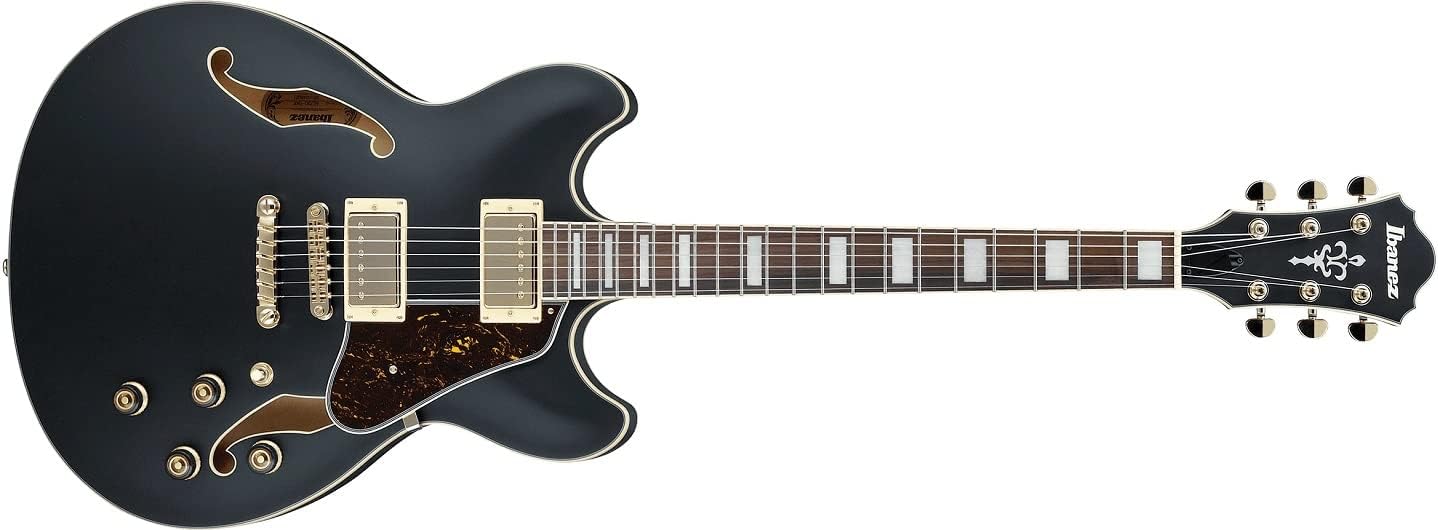
The Ibanez Artcore Series AS73G is an electric guitar designed with a semi-hollow body that is double cutaway in shape.
Boasting of a solid wood construction, the instrument features top and body wood made from maple.
The guitar has a right-hand orientation and a sleek, satin finish adds charm to its appearance.
It presents a Speed neck made from quality mahogany and employs a bolt-on joint.
This model boasts of a 25.5-inch scale length and comes with a standard truss rod.
The neck has a satin finish and the fretboard is made of bound rosewood, adding to the guitar’s premium quality.
Crafted with a bold design and luthiery expertise, this semi-hollow masterpiece showcases Ibanez’s commitment to warm and full-bodied tone.
As part of the Artcore collection, this model carries forward the brand’s legacy and seeks to redefine the potential of great hollow or semi-hollow instruments.
The AS73G model particularly features a select-grade semi-hollow Maple body, an integrated mahogany neck, and a rosewood fretboard that contributes to its rich, warm tone.
It’s furnished with Classic Elite pickups aimed at delivering meaty, balanced output.
This guitar is offered in a flat black color and its strings and scale, hand orientation and material types for various components, further attest to its superior build quality
- My Review
Upon first impression, the Ibanez Artcore Series AS73G Semi-Hollowbody Electric Guitar carries an unquestionable aura of sophistication and craftsmanship.
In a rich and captivating shade of flat black, it is clearly a treat for the eyes.
The guitar delivers a remarkable combination of solid wood construction, comprised of maple body and top wood, and a sleek mahogany neck.
One aspect of this semi-hollowbody electric guitar that truly stands out is its meticulous design focusing on the right-handed orientation of the player.
What also grabbed my attention is the guitar’s bound rosewood fretboard, embellished with medium-sized stainless frets.
Right from the first strum, I could feel the rich full-bodied tone synchronized beautifully with the guitar’s 25.5-in scale length, giving me a vivid sense of unmitigated control over the instrument.
I was indeed amazed at how easily I could customize the sound with the guitar’s speed neck design and the adjustable truss rod.
However, all that glitters is not gold, and there are spaces for improvement in the Ibanez Artcore Series AS73G Semi-Hollowbody Electric Guitar too.
I found the pickups, while designed for a big full-tone output, could sound overly bright at times which might not suit all musical styles.
It should be noted that the bridge pickup, in particular, is leaning towards punchiness rather than warmth, which can be a positive or negative, depending on personal preference.
Moreover, I noticed that the saddle for the strings is somewhat far from the bridge pickup, which might affect the ability to achieve perfect intonation.
You would also feel the unique warmth imbued into the guitar by its selection of high-grade materials including bound rosewood fretboard, mahogany neck and maple body.
However, despite the minor issues, the instrument’s nimbleness, jazzy timbre and rock-friendly responsiveness are the reasons why I fell in love with it.
This instrument resonates with a legacy of more than three decades, joined by other giants of jazz guitar such as George Benson, Pat Metheny, and John Scofield.
The Ibanez Artcore Series AS73G Semi-Hollowbody Electric Guitar is not just a musical instrument, but rather a testament to the constant evolution in the world of hollow and semi-hollow guitar building.
- Pros:
- Warm, Full-Bodied Tone.
- Easy Playability.
- Durable Built.
- Cons:
- Potential Intonation Issues.
- Saddle may be too far.
- Original Strings of Low Quality.
My final verdict is that, the Ibanez Artcore Series AS73G Semi-Hollowbody Electric Guitar Flat Black truly lives up to the brand’s reputation.
This guitar is not only well-built and aesthetically pleasing, but also delivers on sound quality.
The maple semi-hollow body, mahogany neck, and rosewood fretboard contribute to a warm, full-bodied tone that’s sure to please.
Additionally, its Classic Elite pickups give a well-balanced output that suits all kinds of music genres.
Therefore, I highly recommend this guitar to anyone seeking a versatile, high-quality instrument.
Epiphone Sheraton II Pro Electric Guitar
Premium semi-hollow guitar with ProBucker pickups.
Built with laminated Maple top, back and sides, this semi-hollow body guitar features a ’60s Slim Taper profile neck made of Hard Maple/Walnut laminate. It boasts high quality ProBucker 2 and 3 pickups with coil taps, along with a Graphtech NuBone XL nut and a Lock Tone Tune-o-matic bridge. Finished in a rich Ebony Gold hardware color, it reflects the brand’s dedication to combining classic aesthetics and modern technology.
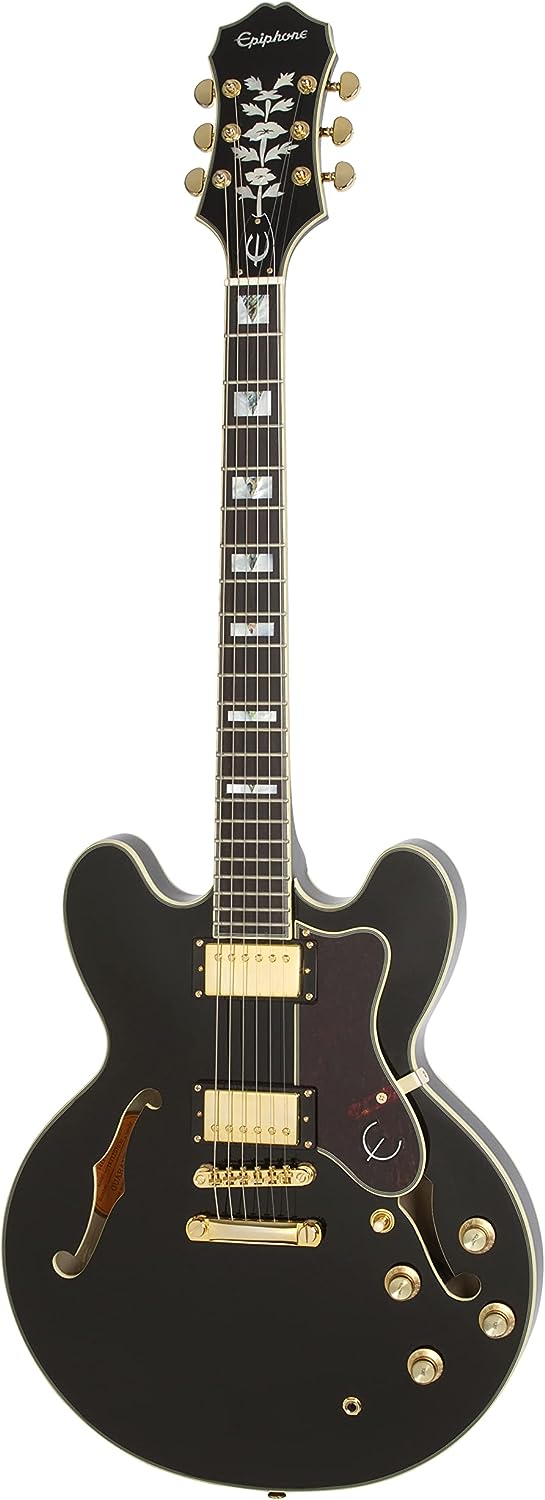
Made by the reputable brand Epiphone, the Sheraton II Pro Semi-Hollowbody Guitar is a noteworthy instrument that sports a sleek design in an Ebony Gold Hardware shade.
Its body and top are crafted from durable laminated Maple wood, simultaneously offering an alluring aesthetic and promising longevity.
Adding to the overall appeal, the guitar features a unique 5-piece laminated alternating Hard Maple and Walnut neck design, showcasing Epiphone’s commitment to quality and detail.
It features a smoothly tapered ’60s Slim Taper neck profile, complemented by a comfortable, well-made Rosewood fingerboard adorned with stunning pearloid and abalone inlays.
Boasting a Graphtech NuBone XL nut and medium-jumbo frets, this instrument is ready to deliver impressive and consistent sound quality.
Underneath its elegant design, the Sheraton II PRO is equipped with top-of-the-line ProBucker 2 and 3 pickups, which are perfectly paired with coil taps on the Neck and Bridge Volume knobs.
All of this is anchored by the tuning stability provided by the Lock Tone Tune-o-matic bridge and Stop Bar Tailpiece.
Some additional key information to note includes its H-H pickup configuration, right hand orientation, and the use of Pau Ferro Wood for the fretboard, which enhances the playability of the guitar.
In the spirit of maintaining Epiphone’s legacy, the Sheraton-II PRO resembles the brand’s influential, “thin-line” semi-hollow body electric archtop and comes up with a beautiful Wine Red finish.
This wonderful instrument is set to deliver outstanding performance whilst being a visually stunning piece of workmanship.
- My Review
First of all, I have to point out the beautiful design of the Epiphone Sheraton II Pro Semi-Hollowbody Guitar.
It strikes an impressive aesthetic balance with the ebony gold hardware, that lends it an elegant, professional look.
Upon handling, it became apparent that the laminate maple top, back, and sides gives this guitar a strong, resonant sound.
The quality of these materials was unmistakable to the trained ear.
I felt the 5-pc Hard Maple/Walnut laminate neck design, coupled with a ’60s Slim Taper neck profile, enhanced the playability of this guitar. It’s a feature that I feel, brings a vintage touch to this modern instrument.
What captured my attention next was the Rosewood fingerboard with pearloid and abalone/block and triangle inlays.
This is a tasteful design choice, adding another layer of elegance to this guitar.
To ensure maximum tuning stability and sustain, the Epiphone Sheraton II Pro Semi-Hollowbody Guitar has a Graphtech NuBone XL nut and Lock Tone Tune-o-matic bridge and Stop Bar Tailpiece.
This lends it a sense of steadiness, and helped maintain the guitar’s tune during long hours of playing.
I noticed that the ProBucker 2 and 3 pickups along with coil taps on the Neck and Bridge Volume knobs exponentially expands the tonal options.
These elements render enhanced tonal flexibility which caters to multiple music genres. I observed crisp and rich tones, be it acoustic rock, jazz or blues.
I also enjoyed the ease of play that this guitar presented. The setup right out of the box was quite solid.
However, I found that replacing the original strings delivered a heightened performance and better user experience.
As much as I appreciated this guitar, there were areas that required polishing, literally. The frets were somewhat rough and could benefit from some polishing and leveling for targeted action adjustment.
Enhanced fret finishing could allow for a smoother play, and less strain on the fingers.
Another area that stood out was the finish on the fingerboard. It stained my fingers black after extended hours of playing.
This was a minor annoyance, and could be easily remedied with proper cleaning and maintenance over time.
Considering the quality and plethora of features, the Epiphone Sheraton II Pro Semi-Hollowbody Guitar is a commendable instrument especially for its price range.
It does require some initial setup tweaks and adjustments but then transforms into a solid, well-playing instrument with a superb tonality and aesthetic appeal.
- Pros:
- Great sound quality.
- Highly playable and adjustable.
- Quality build and appealing design.
- Cons:
- Potential for quality control issues.
- Initial setup may be required.
- Factory strings may need replacing.
My final verdict is that the Epiphone Sheraton II Pro Semi-Hollowbody Guitar is a fantastically crafted instrument.
The combination of laminated Maple and Hard Maple/Walnut provides a rich and full sound that is hard to match.
With its ProBucker 2 and 3 pickups and coil taps on the Neck and Bridge Volume knobs, you have unparalleled tone control and versatility at your fingertips.
The Wine Red finish and ebony gold hardware make it not only a joy to play, but a visual treat as well.
In short, it provides excellent value for its price point, making it a great choice for both beginners and experienced guitarists alike.
What to Look for When Purchasing Electric Guitars for Gigging?
When embarking on the journey of purchasing an electric guitar for gigging, there are numerous facets to look for.
Determining your budget is an essential first step since it helps to narrow down your options and preventing overspending.
Having a clearly defined budget will allow you to focus solely on guitars within that range, providing an manageable selection to pick from.
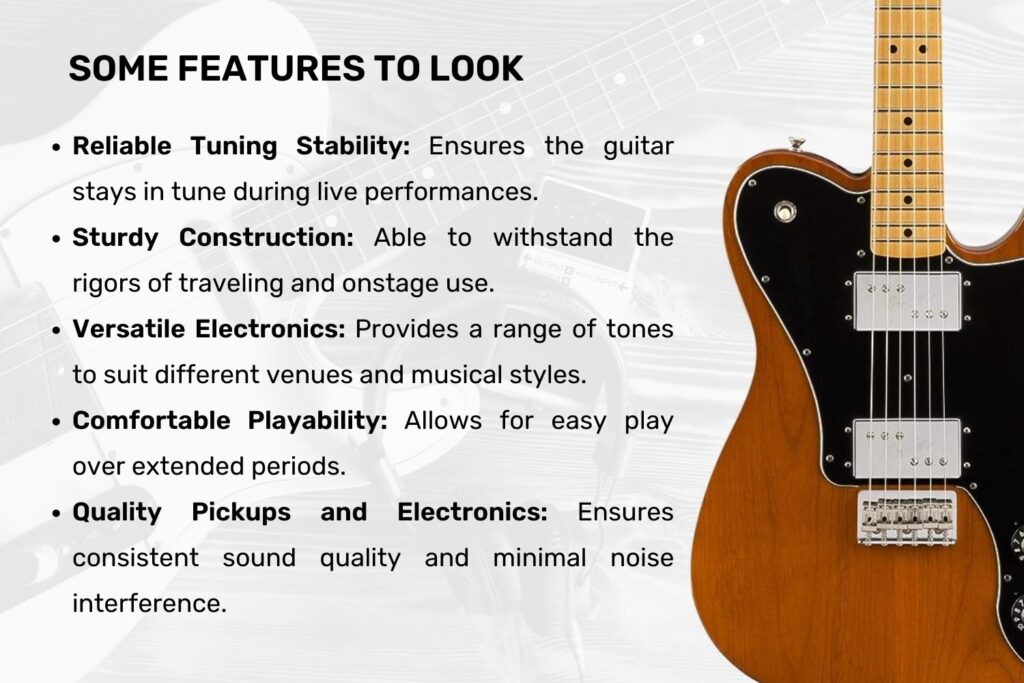
One must not forget that top-tier guitars often come with a higher price tag, however a higher price doesn’t necessarily constitute the best guitar for your individual needs.
The type of music you plan to play should strongly influence your guitar selection.
For instance, if you’re heavily into rock, you might want to consider guitars that have humbucker pickups like a Gibson Les Paul, while a Fender Stratocaster might be more appropriate if you’re into blues, jazz or country.
Roadworthiness should be a fundamental consideration if you’re purchasing for gigging.
As much as all guitars are beautiful, not all are built for the physical stress and rigors of touring.
Researching on the guitar’s construction and inquiring about its roadworthiness from owner reviews and forums can prevent you from purchasing a guitar that won’t withstand the rigours of regular gigging.
A guitar’s comfort and playability are equally important aspects to consider.
Playing for hours on end can become uncomfortable if the guitar’s neck is too wide or too slim for your hands.
It’s always advised to visit a music store and physically try out the guitar to check for neck comfort, weight distribution and general feel.
The guitar’s tone quality is highly crucial, and nothing can be more disastrous than purchasing a guitar that doesn’t suit your tonal preference.
Your choice of guitar should respond well to volume changes and have a balanced tone.
In this respect, remember that an electric guitar’s sound is influenced by its materials, construction and the type of pickups used.
Finally, the guitar’s aesthetics might be the last on your checklist, but it is an essential factor as well.
Having a guitar that you find visually appealing and resonates with your style not only aids in your performance, but it also motivates you to play more.
Always remember, when selecting a guitar for gigging, you are investing in a tool that will be with you for a significant period.
So, don’t hesitate to take your time, do your due diligence, and find a guitar that feels like an extension of your musical personality.
How Do You Determine Guitar Quality?
When it comes to purchasing an electric guitar for gigging, one needs to take into account several parameters to gauge the quality of the guitar.
First and foremost, the materials utilized in the construction of the guitar is a significant aspect of defining the guitar’s quality.
High-grade woods like maple, mahogany, and rosewood, which are typically used in the construction of quality guitars, ensure excellent sound resonance and optimal durability.
Secondly, the construction of the guitar tells a great deal about its quality.
Typically, a well-constructed guitar promises to offer a better overall sound and a longer lifespan.
This includes a close inspection of the guitar’s neck, body, and hardware for any signs of inferior workmanship such as poorly finished frets or cracks in the wood.
Then, the topic of the sound produced by the guitar is a direct indication of its quality.
A rich, full, and balanced output, free from buzzing noises or dead spots on the fretboard, points towards a quality guitar.
The consistency and evenness of the guitar’s tone, the clarity of the midrange frequencies, and the sharpness of the trebles are aspects that need to be evaluated.
The playability of the guitar can also help determine its quality.
This refers to the ease of playing the guitar, including the feel of its neck, the action of its strings, and the positioning of the fretboard. https://youtu.be/HAlj5d77gFQ
A guitar that is comfortable to play, and requires less effort to produce clear and pleasant sounds, can be considered a quality guitar.
Finally, the brand reputation and user reviews can provide additional insights into the guitar’s quality.
A renowned brand with consistently good user reviews is usually a safe bet for quality guitars.
However, given the personal nature of a musician’s relationship with their instrument, it’s important to try out a guitar and get a personal feel before making a purchase.
By considering these aspects – the guitar’s materials, construction, sound, playability, brand reputation, and user reviews – you can begin to determine the quality of a guitar and its suitability for gigging.
Is Wood Quality Important for Electric Guitars?
The quality of the wood used in the construction of an electric guitar greatly impacts its tone, durability, and overall performance.
This is because the wood, often referred to as the guitar’s tonewood, affects how the guitar vibrates and resonates, which in turn influences the sound it produces.
An electric guitar produced from high-quality wood, for instance, will typically enable a richer and more nuanced sound, compared to a guitar made from a low-quality material.

Commonly used tonewoods in electric guitar construction include maple, mahogany, alder, and ash, each with their distinct tonal characteristics and aesthetic appeal.
Maple, for instance, is known for its bright and clear tones, while mahogany can produce warm and full-bodied bass tones.
Alder and ash, on the other hand, offer balanced tones with strong sustain, making them ideal for a wide range of music styles.
Therefore, a guitarist looking for a particular tonal quality might prefer a guitar made from a particular type of wood.
Aside from influencing the guitar’s tone, the quality of wood also affects the durability and longevity of the instrument.
High-quality wood, especially when properly dried and treated, can withstand the rigors of regular use and the environmental stresses that come with gigging, such as changes in temperature and humidity.
On the contrary, guitars constructed from low-quality wood or improperly treated wood can suffer from issues such as warping, cracking, or changes in sound quality over time.
It’s also worth noting that the type and quality of the wood can vastly affect the guitar’s weight, and by extension, the comfort of the player during long gigs.
While a heavier guitar made of, say, dense mahogany might provide a rich tone, it could also strain the player’s shoulder if they have to stand for a long duration during a gig. Conversely, a lighter guitar made of alder or ash might be easier to handle over long periods.
As such, choosing the right wood is often a balance between tonal considerations, durability, and playability.
Finally, it’s crucial to mention that the quality and type of wood used in a guitar also contribute significantly to its visual appeal – an important factor for a performer on stage.
High-quality wood with attractive grain patterns, beautifully crafted into a guitar’s body, neck, and headstock can make a guitar a true work of art, as much as it is a musical instrument.
While there are other materials involved in the makeup of an electric guitar, none play as profound a role as the wood when it comes to the instrument’s tone, durability, visual appeal, and ultimately, its performance.
It is, therefore, essential for guitarists, especially those who gig regularly, to pay close attention to the quality and type of wood in their instrument when making their purchasing decisions.
How Essential is the Pick-Up System for Electric Guitars?
The pick-up system in an electric guitar is incredibly essential, as it is the component that translates the vibrations of the strings into an electronic signal, which can then be amplified and modified to produce a vast array of sounds.
Without a good quality pick-up system, an electric guitar will struggle to accurately convey the notes being played and may result in a poor sound output.
There are several types of pick-up systems available, each working in a slightly different way to pick up the sound of the strings and each generating a different tone.
The single-coil pickup, for example, produces a bright and punchy tone, but can also introduce a level of unwanted noise.

The humbucker pickup, on the other hand, uses two coils to eliminate this noise, resulting in a warmer and fuller sound.
There are also P90 pickups, which combine elements of both single-coil and humbucker pickups to offer a unique tone with a high output level.

The type of pickup that is best for gigging will largely depend on the type of music you will be playing, as well as your personal preference for tone.
Aside from the type of pickup, it’s also crucial to consider the quality of the pickup.
Higher quality pickups will generally offer a fuller, richer tone and will more accurately translate the sound of the strings into an electronic signal.
However, it should also be noted that just because a pickup is expensive, does not necessarily mean it will be the best fit for your needs.
It’s always a good idea to try out several different types of pickups to see which you prefer and which best suits your playing style and musical genre.
A crucial feature of any good pickup system is its pickup switch.
This control allows you to blend the signals from multiple pickups in various ways, thus giving you a wider variety of tones to choose from.
The pick-up system plays a vital role in the sound output and versatility of an electric guitar and should therefore be a significant consideration when purchasing a guitar for gigging.
What Role Does the Neck Play in Electric Guitars?
Electric guitars, by their very design, have a variety of components that contribute to their overall sound and playability.
One of the most critical of these is the neck.
The neck has a significant impact on both the performance and the tonality of the instrument.
It’s essential for any guitarist to understand just how much this single component can influence their sound.
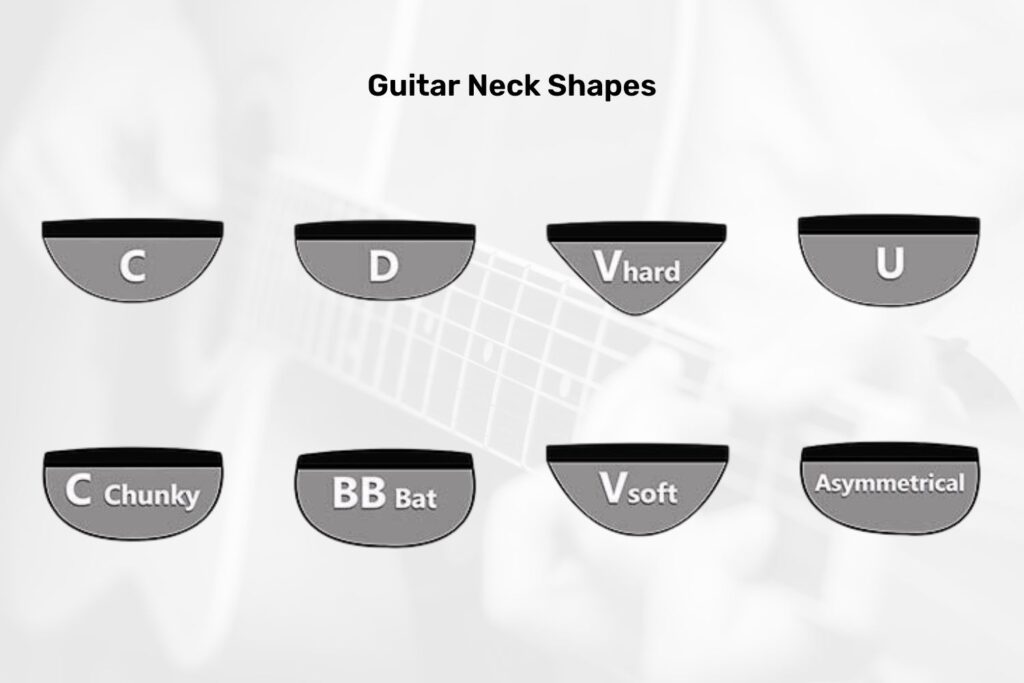
From the construction material to the shape and thickness, the neck encompasses many factors that can significantly shift the tone and feel of the guitar.
Materials used in the construction of the neck play a large role in shaping the sound of an electric guitar.
Different types of wood, such as maple, mahogany, and rosewood, impart their own unique tonal flavors.
For instance, maple necks are known for their bright and snappy tone while mahogany necks tend to offer a warm, rich sound.
Another crucial factor is the thickness and shape of the neck.
Guitarists with small hands might find thin and flat necks to be more comfortable, while those with larger hands might prefer a chunkier, rounder neck.
The neck shape not only affects the comfort level during play but also impacts the speed at which a guitarist can move around the fretboard.
Speaking of the fretboard, it’s another contributing factor to the overall feel and sound of the instrument.
A smooth, well-polished fretboard allows for seamless transitions between notes and chords, making fast passages and complex rhythms easier to execute.
Another aspect worth touching upon is the neck joint type.
Guitars can either have bolt-on, set-neck, or neck-through construction, each with its own specific advantages and tonal characteristics.
Bolt-on necks, which are the most common type, offer snappy and punchy tones and are easily replaceable in case of damage.
Set-neck guitars provide more sustain and resonance but are harder to repair, while neck-through guitars offer the best sustain and resonance but are the most expensive to manufacture and repair.
Finally, truss rod adjustments are integral in achieving and maintaining the optimal neck curvature for superior playability and tone.
Improperly adjusted truss rods can lead to issues such as fret buzz or high action, which can negatively affect the performance of the guitarist.
When choosing an electric guitar for gigging, the neck should be given equal consideration alongside other elements such as the body shape, pickups, and electronics.
The neck truly plays a central role in determining how well an electric guitar performs and sounds.
Can You Explain the Importance of Guitar Electronics?
When discussing electric guitars, it’s essential to understand the significance of guitar electronics.
First, let’s get a grasp on what guitar electronics are.
They are a system of electrical components that include pickups, switches, pots (potentiometers), and jacks.
Their primary function is to change the string vibrations into an electrical signal that can further be amplified and modified.
Therefore, it’s safe to say that these electronics are essentially the heart of an electric guitar.
Pickups, often being the most spoken about, function as transducers that capture the string’s vibration and convert it to an electric signal.
There’s an extensive range of pickups available, each with their distinct sound character.
The difference in sound aesthetics primarily depends on the type of magnet used and the construction of the pickups.
In understanding gigging needs, musicians often opt for humbucker pickups for their powerful output and their ability to cancel out noise.
Switches and pots come next in the signal chain, allowing the performer to control the pickup selection, volume, and tone.
These allow the artist to alter the sound output instantly and play with a tonal variety during a live performance.
The quality of these components significantly impacts the overall sound signal and, consequently, the guitar’s tonal quality.
The last piece in the guitar electronics puzzle is the jack, where the guitar connection to an amplifier or sound system begins.
A weak or faulty jack can lead to unreliable connections and plagued performances, thus underlining its importance in a gigging scenario.
While investing in a guitar for gigging, bear in mind to look for high-quality electronics that can withstand regular and rugged usage.
Often, professional musicians bring spare guitars during gigs or replace their electronics regularly to ensure consistent sound quality and avoid any technical glitches.
There are many aftermarket upgrade options available if the stock guitar electronics do not suffice.
However, such upgrades should be carried out by experienced professionals to maintain the guitar’s inherent character and ensure compatibility.
One more important factor impacting guitar electronics’ performance is the guitar’s setup and shielding.
A poorly shielded guitar might be prone to unwanted interference and noise, especially in a high-gain setting typical of rock and heavy metal gigs.
Providing a well-executed shielding job can drastically reduce unwanted noise and improve the output quality.
Hence we conclude that the importance of guitar electronics in an electric guitar, especially in a gigging situation, is profound.
They are the defining factor when it comes to sound personalization and control, and an integral part of the instrument that lets it be as expressive as we know it to be.
In the end, it’s about finding the right balance between a guitar’s different elements, including its electronics, that mesh well with your unique playing style and sound, especially when it comes to a gigging scenario.
How to Maintain Electric Guitars for Gigging?
Maintaining electric guitars for gigging is an essential part of a guitarist’s responsibility.
One of the primary parts of this upkeep is regular cleaning.
Regular cleaning ensures that the sweat, oil, and dirt which accumulate from constant use don’t tarnish the guitar’s finish and can prolong its longevity.
When cleaning, it’s important to use a soft, dry cloth and specialized guitar cleaning products.
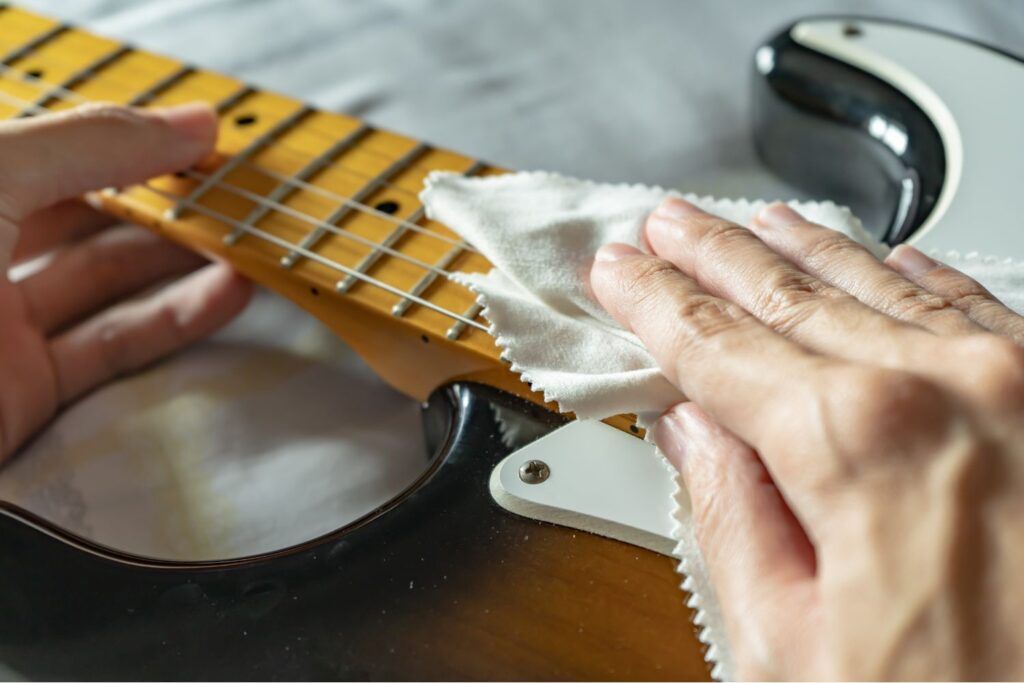
Avoid using harsh cleaning items such as alcohol or household cleaners, which can damage the guitar’s finish.
Additionally, the strings of the guitar need frequent changing.
Occasionally, these can corrode or break, losing lots of their original sound quality.
Thus, musicians performing at gigs regularly should change their strings every three to four gigs or whenever they start to lose their tone or start to look rusty.
Moreover, remember that the type of strings you decide on will impact the guitar’s sound output, so choose wisely.
Another aspect to consider in maintenance is the truss rod adjustment.
The truss rod is an adjustable metal rod that runs along the inside of the neck, and can be used to correct roundness (known as the relief) of the neck.
A guitar with a properly adjusted truss rod will be more comfortable to play, and will maintain better tuning stability.
Electronics, such as the pickups, selector switch, volume and tone controls, are another important aspect of electric guitars that require routine inspection.
Carefully check these parts for any loose wires or any other issues that could affect the guitar’s sound output at gigs.
If your guitar’s output suddenly cuts out during a gig, there’s a good chance it may be a loose wire or a poorly soldered connection.
Also, keep a watchful eye for any changes to the body or neck of the guitar.
If you notice any warping, cracking, or other signs of wear, consult a professional luthier.
Their expertise can be invaluable in maintaining your guitar’s quality and longevity.
Lastly, don’t underestimate the importance of a quality guitar case.
An appropriately sized, padded case can protect your guitar from accidental damage while travelling between gigs.
By incorporating these tips into your routine, you can extend the life of your electric guitar and keep it gig-ready.
Are Some Electric Guitars More Durable for Gigging?
When frequent live performances are part of your routine, durability in an electric guitar becomes a key factor.
This question probes into the elements that make some guitars more apt to withstand the rigors of regular gigging.
Much like any instrument, an electric guitar’s durability is significantly influenced by its construction material and the quality of its craftsmanship.
High-end guitars usually employ high quality hardwoods which are known for their strength and resistance against wear and tear.
For example, mahogany, ash, and alder are commonly used for guitar bodies owing to their robustness.
On the other hand, the guitar’s neck, which tends to be more susceptible to damage, is often made from one piece of solid wood like maple or mahogany, enhancing its strength.
Furthermore, proper binding of the neck and body of the guitar is essential for resilience as any weak joins can become points of vulnerability.
When it comes to hardware, guitars with higher-quality tuners, bridges, and tailpieces generally exhibit a greater endurance.
For instance, tuners made from solid metal are likely to have excellent wear resistance and longevity.
Similarly, the pick-up system plays a critical role in a guitar’s resilience.
Well-made pick-ups are resistant to damage from falling or being hit, and can withstand prolonged exposure to high volumes without distorting the sound.
Good quality control in the manufacturing process is another factor that greatly influences a guitar’s durability.
Guitars crafted meticulously will invariably offer a better lifespan as compared to mass-produced ones that often compromise quality for quantity.
Notably, electric guitars that have a polyurethane or polyester finish have an added advantage.
This kind of finish makes the guitar more resistant to scratches, dings, and other minor damages common during gigs.
Guitars bound in these materials can efficiently bear the brunt of onstage accidents or even rough tote-a-long tours.
However, having a guitar with all these features does not exonerate one from regular maintenance.
Even the most robust electric guitar will eventually succumb to the wear and tear if not routinely maintained.
Ensuring the guitar is cleaned and stored properly, regularly checking and replacing strings, and getting any operational issues fixed promptly can significantly prolong a guitar’s life.
Therefore, from the wood type, the build process, to the hardware and its finish, many factors in combination determine the durability of an electric guitar.
And while you may need to invest a bit more initially, getting a durable guitar can save costs and trouble in the long run, particularly for regular gig players.
Does the Guitar Size Impact its Sound Output?
When it comes to electric guitars, there are a plethora of factors that can influence the overall sound output.
In particular, the size of the guitar can have a considerable impact on the tone that it produces.
Physics is the science behind this phenomenon, as sound is produced when the guitar’s strings are strummed, causing them to vibrate.
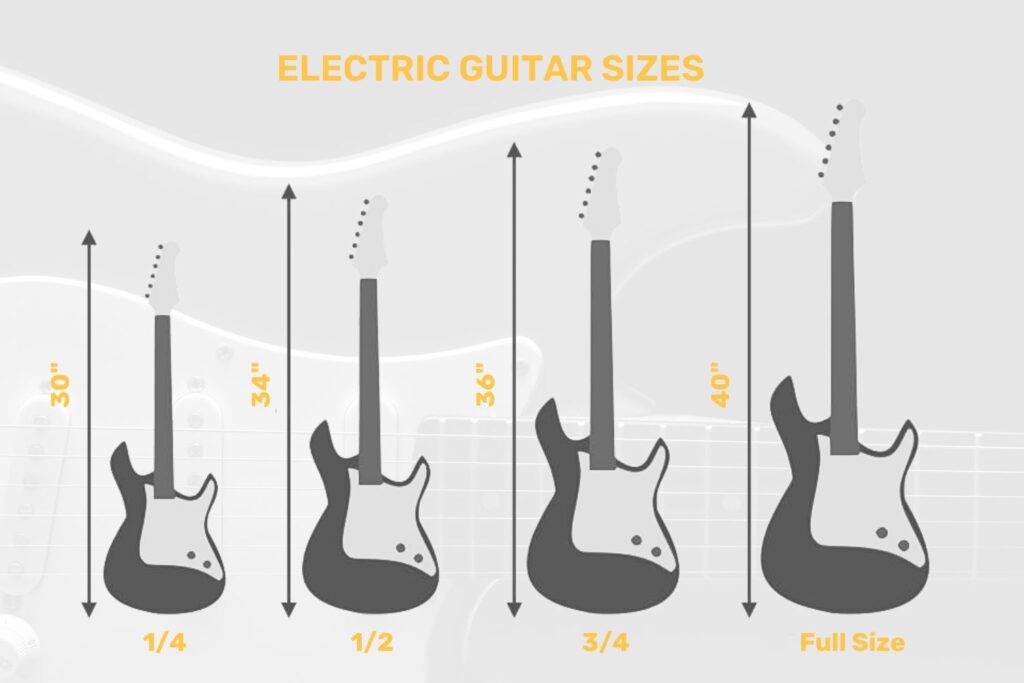
These vibrations are then transmitted to the guitar body, which in turn vibrates and amplifies the sound.
In general, larger guitars will have more internal space and thus produce louder, deeper tones than their smaller counterparts.
On the other hand, smaller guitars tend to produce sharper and brighter tones, which might not be as loud, but would certainly cut through in a mix.
But, size shouldn’t be the only thing you consider when gauging the impact on sound output.
The shape of the guitar also plays a crucial role in determining its sound.
For instance, a guitar with a deeper body might produce more uncharged frequencies, hence, offering a warmer and more resonating tone.
In contrast, a shallower body can produce a crisper sound, albeit with slightly less resonance.
Moreover, the inherent material properties of the guitar’s body will also contribute to the overall sound profile.
Different types of wood have distinctive tonal characteristics, so even with the same shape and size, two guitars can have different sounds if they’re made from different wood types.
The string scale length, or the distance between the bridge and the nut of the guitar, should also not be overlooked.
Generally, longer scale lengths produce more tension on the strings, leading to a brighter tone with more sustain, while shorter scale lengths result in a warmer, mellower sound.
On the whole, it’s important to note that each individual element of a guitar can impact the sound output.
Therefore, while the size of a guitar could change the tone and volume, it is by no means the only factor at play.
In fact, each of these aspects work together in harmony to create the unique sound that we hear from the instrument.
As such, it’s crucial to try multiple guitars before settling on one, as each guitar will have a different size, shape, construction, and material characteristics.
This will allow you to find one that resonates with you and accurately represents your desired sound output.
The size of the guitar can have a significant effect on its sound output, but it is just one variable among many that should be considered during the purchasing process.
What Kind of Electric Guitar Strings are Best for Gigging?
Choosing the ideal strings for your electric guitar for gigging is crucial because they play a significant role in the overall playability, tone, and comfort level of your instrument.
The first factor to consider is the material of the strings.
The most popular materials are nickel-plated steel, pure nickel, stainless steel, and coated strings. Nickel-plated steel strings offer a balanced tone for rock, blues, and all genres of music, making them the most common choice for guitarists.
Pure nickel strings, on the other hand, have warm, vintage tones and are ideal for genres such as blues and jazz.
Next, stainless steel strings are well-loved for their bright, crisp tones and corrosion resistance. If you play chunky riffs or need more clarity in your tone, these strings might be a good fit.
Lastly, coated strings last longer due to a special treatment that protects them from sweat, oils, and dirt. However, they do change the tone somewhat, so they must be chosen after careful consideration.
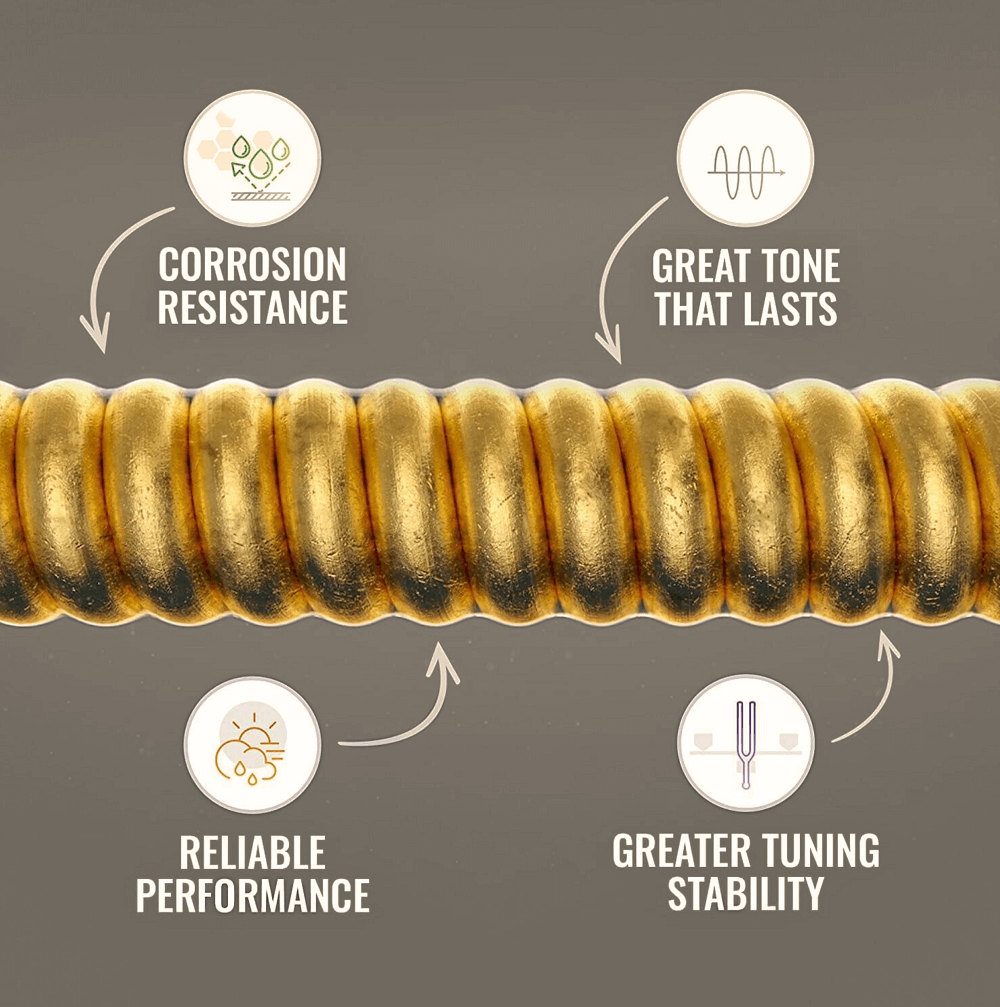
Gauge or string thickness is another significant consideration when choosing electric guitar strings for gigging.
Lighter gauge strings (around .009-.042) are easier to play, ideal for pitch bending and fast lead work, but might lack the volume and resonance of heavier strings.
Heavier gauge strings (around .011-.052 or higher) offer more volume and sustain but require more finger strength and control to play. They’re a favorite among jazz, hardcore rock, and metal musicians.
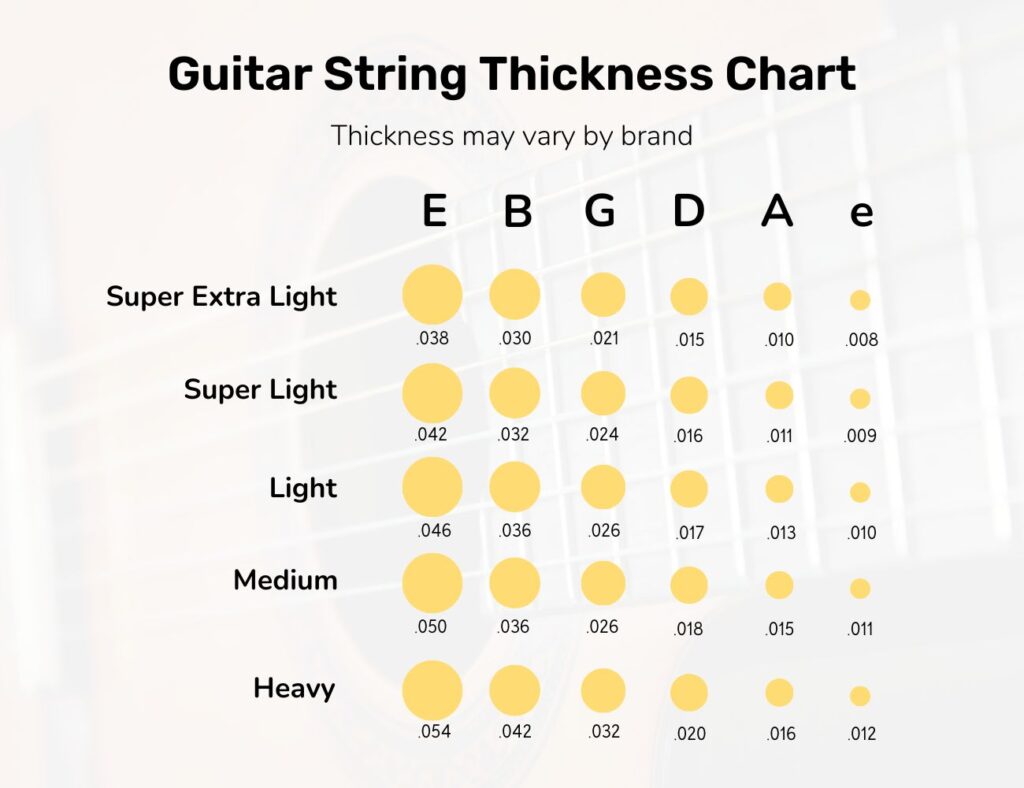
The choice of the string gauge will also depend on your guitar’s setup, style of music, and personal preference.
Another aspect to consider when choosing guitar strings for gigging is the round-wound versus flat wound.
Round wound strings are the most popular and offer a bright tone with a textured feel, great for rock, metal, blues, etc.
Flat wound strings, on the other hand, have a smoother feel and produce a darker, mellow tone preferred by many jazz and blues guitarists.
The last thing to consider is your personal preference and comfort level. The best strings should make it easier to produce the sound you want and should feel right.
Keep in mind that even the best electric guitar strings will not sound good if they are not changed regularly.
So, whether you are a professional musician or just starting, choosing the right electric guitar strings for gigging can make a huge difference to your overall music performance.
The Bottom Line
After evaluating numerous options, it’s clear that the best electric guitars for gigging are made for performance.
They are incredibly durable and sound amazing on stage.
They have the precision and depth of tone professional musicians seek.
Whether you’re playing small club shows or full-scale concerts, these guitars are reliable companions on stage.
Whether you’re a hobbyist or a seasoned pro, rest assured there’s a guitar out there for you.

More than 10 years of experience playing and writing about guitars! When not writing, I can be found strumming away some Johnny Cash tunes. Favorite all time guitar is the Gibson Les Paul. #TeamGibson




